

Lee Jae-myung
Elected President



Gwangju & South Jeolla International Magazine
From the Editor

July 2025, Issue 281
Published: July 1, 2025

Cover Photo
The Inauguration of Lee Jaemyung at the National Assemby of Korea.
Photo credit: @2_jaemyung on Instagram.
Publisher Dr. Shin Gyonggu
Editor-in-Chief Dr. David E. Shaffer
Copy Editing Dr. David E. Shaffer
Layout Editor Johanna Lezada
Online Editor Johanna Lezada
The Gwangju News is the first English monthly magazine for the general public in Korea, first published in 2001. Each monthly issue covers local and regional issues, with a focus on the roles and activities of the international residents and local English-speaking communities.
Copyright ©2025 by the Gwangju International Center. All rights reserved. No part of this publication covered by this copyright may be reproduced in any form or by any means –graphic, electronic, mechanical, photocopying, recording, or otherwise – without the written consent of the publisher.
The Gwangju News is published by the Gwangju International Center: Jungang-ro 196-beon-gil 5 (Geumnam-ro 3-ga), Dong-gu, Gwangju 61475, South Korea
Tel: (+82)-62-226-2733
Fax: (+82)-62-226-2731
Website: www.gwangjunewsgic.com
Email: gwangjunews@gic.or.kr
Registration No. 광주광역시 라. 00145
ISSN 2093-5315
Registration Date: February 22, 2010
For volunteering and article submission inquiries, please contact the editor at gwangjunews@gic.or.kr

It’s July! Already the latter days of June alerted us to the fact that the heat of summer and the dog days that it embraces were upon us. Our article on Korea’s dog days (Sambok) provides information on their origin, traditional foods that are eaten, and how to make this a more sustainable world, as this summer is already predicted to raise the mercury higher than usual.
Possibly the hottest event of the year in the Republic was the recent presidential by-election. We bring you the twists and turns in the lead-up to the election, insights into the election results by region, and hope for the future under the leadership of the new president, Lee Jae-myung.
Gwangju’s hottest event of the year is arguably the recently concluded World Human Rights Cities Forum, hosted by the city. Moderator of this year’s Forum was Kim Gyeongrae, director of the Gwangju Foundation for Women and Family. We have for you an interview with Ms. Kim on the Foundation’s mission and activities focusing on gender equality among others.
Planning your summer vacation? Consider beating the heat at the Boryeong Mud Festival after reading our article on the event authored by a splasher in last summer’s Daecheon Beach mud. Looking for something even more out of the box? Consider a summery workcamp, such as the Soan-do Workcamp that we bring you a report on. Is your time more limited? How about a balmy day at Gwangju’s recently opened Asian Art Garden with its cultural garden, ecological art garden, and sky bridge.
Read one participant’s exposé on this year’s Mt. Mudeung LiteraryCultural Festival. Read another participant’s account of their experience at Gwangju’s Together Day. Don’t miss our piece on the support provided by diaspora communities, and be sure to read about Korea’s hidden leprosy colony on Sorok-do.
We have for you a burning book review: Bessie Head’s When Rain Clouds Gather. A red-hot report on a bakery that’s more than just a bakery. A cool café review: Tea At in Ssangchon-dong. And a sizzling gel nail review: Unnie’s Nail Salon in Dongmyeong-dong.
In addition to our Area Sports Round-Up, we have an article on the AI Peppers’ newly acquired Shimamura Haruyo. And as usual, we round out the issue with the hottest Upcoming Events for this month. Enjoy!
David E. Shaffer Editor-in-Chief Gwangju
News


Summer Once More
Late last autumn, the crimson leaves that had frozen in the sudden arrival of the first snowfall have somehow returned – now as green once more.
Winter carries summer within it, and summer holds winter deep inside. Just as life and death are not truly separate. Carpe diem.

The Photographer
Kang Hyunsuk (Jennis) was born and raised in Gwangju, the city of art. A lover of nature, she has now chosen to spend a season of her life in Bukhan Mountain in Seoul, practicing to grow flowers in her mind.
Mountain, Seoul.
Photograph taken at Bukhan
CONTENTS July 2025 ISSUE 281
24 The Asian Art Garden: Where Culture Meets Nature in Gwangju
COMMUNITY
27 Heading to Nature for Rest: The Mt. Mudeung Literary-Cultural Festival

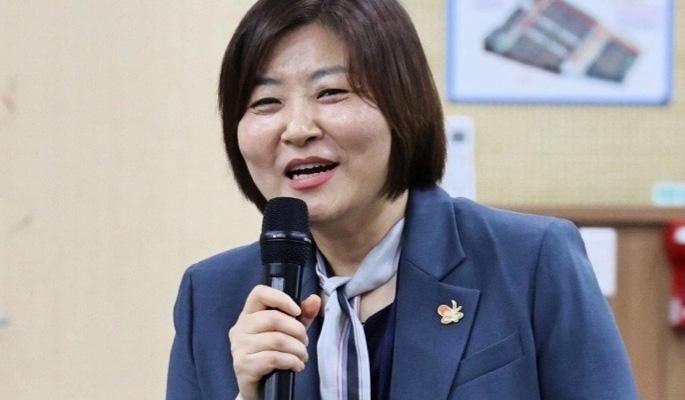
30 Diaspora Communities: A Social Anchor in a Foreign Land
32 Nail Salon Review: Unnie’s Nail Salon – Affordable Gel Nails in Gwangju
34 Experiencing Together Day
CULTURE AND THE ARTS
35 Book Review: When Rain Clouds Gather
FOOD & BEVERAGE
37 Gwangju’s Hidden Gem: A Cozy Place for Tea Lovers
39 Bread, Roses, and Community: A Gwangju Bakery Rises Above Business
PONDERINGS AND CONTEMPLATIONS
42 Sorok-do: Island of Agony
SPORTS & ENTERTAINMENT
44 Area Sports Round-Up
47 From Kawasaki to Gwangju: Shimamura Haruyo’s Next Big Move
48 July Upcoming Events

Photo Credits
09 @2_jaemyung on Instagram
14 Kim Gyeongrae
19 Neha Bisht
Gwangju City News

Lee Jae-myung Elected South Korea’s 21st President
On June 3, 2025, South Korea elected a new head of state in a snap presidential election, held in the wake of former President Yoon Suk Yeol’s impeachment. The early vote was triggered by Yoon’s declaration of martial law on December 3, 2024, which was swiftly followed by the National Assembly’s passage of an impeachment motion, plunging the nation into political turmoil. Amid nationwide attention and a high voter turnout, the country chose its next leader.
Lee Jae-myung of the Democratic Party emerged victorious, securing 48.8% of the vote. His victory was officially confirmed in the early morning hours of June 4, and he assumed office immediately thereafter.
In his inaugural address, President Lee emphasized the importance of unity, declaring, “It is the president’s duty to bring the people together. Let us build a fair and inclusive nation where everyone has equal opportunities and no one is left behind.” He called for a society grounded in mutual care and equitable growth.
Shortly after taking office, President Lee outlined his first major policy agenda, centered around five key national priorities:
• Healing the wounds of internal unrest and restoring social stability
• Overcoming the economic crisis and revitalizing livelihoods
• Ensuring public safety and protecting citizens’ lives
• Establishing a peace regime on the Korean Peninsula
• Advancing practical efforts toward national unity
This snap election carried significance beyond a mere change of administration. It was seen as a public reckoning against the abuse of power and a step toward the restoration of democratic values. As such, expectations are high for the new administration to demonstrate strong leadership during this period of national crisis.
An early public opinion survey on President Lee’s first week in office showed a positive approval rating of 58.6%, reflecting the public’s cautious optimism. However, deep divisions remain in Korean society following the impeachment, and the success of the new government will hinge on its ability to promote inclusivity, foster dialogue, and implement meaningful reforms.
Major Fire Hits Gwangju’ s Kumho Tire Plant
On the morning of May 17, a massive fire broke out at the Kumho Tire plant in Gwangju, severely damaging more than half of its production lines. Nearly a month after the incident, the full restoration timeline remains uncertain. Public concern grew after it was revealed that fire-related debris was discharged into the Hwangryong River.
A significant amount of contaminants appears to have mixed with rainwater and flowed into the river, though the exact level of pollution has yet to be determined. Amid growing calls for measures to protect public health and prevent environmental damage, Kumho Tire is facing
Inauguration of the 21st President of the Republic of Korea on June 4 at Rotunda Hall, of the National Assembly Main Building. (Office of the President of Korea)
Gwangju City News
criticism for its delayed and opaque response, which has only heightened anxiety among local residents.
Fire authorities managed to extinguish the main blaze within two days, and investigations into the cause of the fire, as well as recovery efforts, are still underway. The incident has dealt a major blow to the company’s operations, effectively halving its production capacity and putting its annual revenue targets at serious risk.
With prolonged suspension of factory operations, discussions of potential workforce downsizing have surfaced. In light of a previous fire at the company’s Daejeon plant, concerns have also emerged about a possible future shutdown or relocation of the Gwangju facility.
Gwangju Bus Strike Deepens Commuter Disruption
A citywide bus strike in Gwangju has caused significant inconvenience for residents, particularly during commuting hours. The strike was initiated by local bus unions demanding better working conditions, including an 8.2% increase in base salary and an extension of the retirement age to 65. Despite negotiations, no agreement was reached with management, prompting the union to launch a full-scale walkout.
As the strike continued, public attention turned to the wage levels of city bus drivers. As of June 17, a Gwangju city bus driver with eight years of service (pay grade 4) receives a monthly salary of 4.59 million won – comparable to drivers in Daejeon, a city of similar size and economy. However, this figure remains among the lowest for metropolitan cities in South Korea.
The prolonged strike has heavily impacted daily commutes, sparking growing criticism among residents frustrated with the ongoing disruptions.

Although the union temporarily suspended the strike during the three-day Memorial Day holiday, negotiations fell apart again after the walkout resumed on June 9.
During follow-up mediation on June 13, talks broke down as the union insisted on a five percent wage increase. The Gwangju City bus union and management reached an agreement on wages and a collective bargaining agreement on June 20. As a result, Gwangju city buses resumed normal operations on the 21st, after a 12-day strike. There is growing public demand for a swift and sincere resolution through continued dialogue between labor and management, so that citizens may soon return to a stable and reliable transportation environment.
Heavy Rain Alert for Gwangju
Gwangju and the southern regions, including Jeonnam, are experiencing early summer heat with daytime temperatures already exceeding 30°C in June. The Korea Meteorological
Black smoke rises from Kumho Tire’s Gwangju plant, May 17, 2025. (Jeong Yeonseo)
Gwangju City News
Administration has issued a monsoon warning for the southern areas, raising concerns over potential damage caused by heavy downpours.
With the onset of this year’s monsoon season, Typhoon Wutip, the first typhoon of the year moved northward from near Jeju Island. Authorities predicted the possibility of localized intense rainfall reaching 30 to 50 millimeters per hour.
Moreover, as the warm and humid southwesterly winds prevail through July, the monsoon is expected to bring stronger rainstorms and sudden heavy showers than usual. In response, the Gwangju Fire and Safety Headquarters announced the operation of a dedicated “Heatwave Emergency Squad” to address heatrelated illnesses during the summer months.
Officials advise citizens to limit outdoor activities between 11 a.m. and 4 p.m., and when necessary, to use wide-brimmed hats, parasols, and sunscreen for protection against the sun. Gwangju City remains committed to disaster prevention and public safety in the face of climate change, wishing all residents a healthy and safe summer season through the heat and monsoon periods.
Son Heung-min Leads
Tottenham to Europa League
On May 21 at San Mamés Stadium in Bilbao, Spain, Tottenham Hotspur triumphed over Manchester United with a 1-0 win in the Europa League final, securing their first European title in 17 years. Son Heung-min, serving as team captain, played in the final and proudly lifted the trophy after the match. This victory marked Son’s first major trophy since turning professional, ending Tottenham’s long-standing title drought.

The fervor surrounding Son continued off the pitch as his match-worn jersey from the UEFA Europa League (UEL) final was auctioned for 76 million KRW (approximately 63,000 USD) on a uniform auction site, reportedly purchased by a dedicated Korean fan.
However, recent developments have also cast shadows around Son. Two individuals have been arrested and charged with extortion and attempted extortion, allegedly using threats related to a disclosure involving Son. The case remains under police investigation.
Looking ahead, Son, who has been a mainstay at Tottenham for a decade, is approaching the end of his contract next summer, sparking widespread speculation about his future. Potential transfers to the Saudi Pro League and Turkish giants Fenerbahçe have been floated in the media, fueling debate about his next career move.
Despite the uncertainties and challenges surrounding him, fans continue to respect Son Heung-min’s decisions and wholeheartedly support him, hoping he will continue to shine no matter which path he chooses.
Compiled by Jung Yeonseo
Son playing for the Tottenham Hotspur. (Dmitry Golubovich/Soccer.ru; CC BYSA 3.0)
The 21st Presidential Election The Birth of a “New South Korea”
By Park Yeonju

The inauguration of Lee Jae-myung as the 21st President, at the National Assembly of the Republic of Korea. (@2_jaemyung / Instagram)
April 4, 2025. Yoon Suk Yeol, the accused, had been impeached. The long struggle of South Korea, which began in the cold winter, had ended. With Yoon’s removal from the presidency, we have confirmed the victory of democracy in South Korea once again. Citizens who took to the streets cheered, and those watching the live broadcast were filled with mixed emotions. According to the current constitution, if a president loses their qualifications, a successor must be elected within 60 days. Once again, the race to create a “new South Korea” with our own hands had begun.
The Campaign
Lee Jae-myung, who faced Yoon Suk Yeol in the 20th presidential election, ran as the candidate for the Democratic Party of Korea. And in the ruling party, the People Power Party (PPP), which was Yoon Suk Yeol’s party, Kim Moonsoo ran as the final candidate. There was a lot of noise in the PPP’s process of selecting the final candidate. Even though Kim Moon-soo was
chosen through the primary, there was a strong movement within the party to unify around Han Deok-su as the candidate, even up until the last minute before the ballots were printed. The reason was the high approval rating of Han, the former prime minister. Several discussions took place. Kim Moon-soo, who was elected through a fair process, expressed that he would not give in. Eventually, through public opinion polls, Kim was confirmed as the final candidate in the presidential race. Lee Jun-seok of the New Reform Party registered as the presidential candidate the fastest, with a slogan promising to represent the voices of young people, especially “men”!
With just about two months left before the election for a new president, there was great interest in the movements of the candidates during this short race. Moreover, given that it was the “election” – the flowering of democracy that breathes new life into us – it was even more significant, especially right after an impeachment. After Yoon’s impeachment, the approval rating in
early April was overwhelmingly in favor of Lee Jae-myung. It was a natural result. Since Yoon, a member of the PPP, had been impeached, there were voices suggesting that the PPP should not even field a candidate. As a result, the initial approval ratings were 37% for Lee Jae-myung, 9% for Kim Moon-soo, and 2% for Lee Jun-seok. Originally, Lee Jun-seok had left the PPP and formed his own party. As a third-party candidate, he did not garner significant support.

Lee Jae-myung’s approval rating remained overwhelmingly high for about a month. A movement to publicly support Lee Jae-myung also emerged in the conservative-leaning region of Gyeongsang-do. Compared to the previous election, this was certainly a change. Even in Gyeongsang-do, which seemed solidly conservative, the increasing support for progressivism was a clear sign of change.
After the failure to replace the PPP candidate with Han Deok-su, Kim Moon-soo was confirmed as their candidate, and the number of people supporting Kim Moon-soo’s steadfast actions grew. Although trust in the PPP itself decreased, more people began to support Kim's refusal to give up. Lee Jae-myung’s approval rating also rose to 51%, but Kim’s approval rating surged to 29%, showing a remarkable increase.
One week before the presidential election, just before the ban on publicizing polls, Lee Jaemyung’s approval rating was about 49%, Kim Moon-soo's about 36%, and Lee Jun-seok’s about 10%. Three debates took place, and it was evident that the gap between Lee and Kim
had significantly narrowed. As election day approached, the traditional conservative base became more united, raising Kim’s approval rating. Lee focused on appealing to the centrist and conservative voters up until the day before the election. Meanwhile, Kim sought to unite with Lee Jun-seok in an effort to maximize conservative support. Their plan was to close the roughly 15% gap by drawing in Lee Junseok, who had around 10% support, and create a dramatic reversal. However, Lee Jun-seok also firmly declared that he would stay in the race until the end, showing his determination.
The Early Vote
The early voting took place over two days, May 30 and 31. The final turnout for early voting was 34.74%, the second highest since the introduction of early voting in 2014. The regions with the highest early-voting turnout were South Jeolla with 56.5%, North Jeolla with 53.01%, and Gwangju with 52.12%. These three regions comprised Jeolla and were the only regions recording an early-voting turnout exceeding 50%. All three candidates participated in the early voting, and they fought hard until the end. Then, on June 3, the much-anticipated main election day came with 14,259 polling stations open nationwide to elect a new president. Unlike regular presidential elections, the voting was held as a by-election, so the voting time was extended by two hours. The final voter turnout was 79.4%, the highest in 28 years. The region with the highest turnout was Gwangju with 89.3%, followed by South Jeolla with 83.6%.
Predicting the Vote
As the gap between the two candidates narrowed, tension remained high until the very last moment. In every election, the deciding factor is often the “floating vote” regions. It is said that looking at the voting results from North Chungcheong Province can predict the election outcome, as it has been accurate in every election from the 13th to the 20th presidential elections, since the restoration of direct voting in 1987. The candidate who received the most votes in this region has always been elected, making it the only region in the 17 metropolitan and provincial
Kim Moon-soo registering as a presidential candidate. (@kimmoonsoo2025 / Instagram)
districts to hold such a record. Among them, the Heungdeok District of Cheongju had consistently predicted the winner with remarkable accuracy. In the 20th presidential election, the gap between the candidates in Heungdeok was similar to the nationwide voting percentage gap. Therefore, this region plays a key role as a barometer of public sentiment and can also predict the margin of victory, making it a traditional deciding region in elections.

Rather than the strong influence of a specific political party, the changing voting patterns of Chungcheong Province in each election are considered very important. Moreover, since this election was being held after the impeachment crisis, changes in the traditionally conservative region of Gyeongsang-do also deserved attention. Additionally, Gyeonggi Province, with the largest number of voters in the country at around 26%, was expected to act as the “deciding vote” that would determine the direction of the election. Furthermore, since both Lee Jae-myung and Kim Moon-soo previously served as the
governor of Gyeonggi Province, all eyes were on who Gyeonggi Province would support. Seoul also has the second-largest number of voters after Gyeonggi Province. Excluding the 20th presidential election, Jeju Island had accurately predicted the winner in all previous presidential elections. People eyed with interest who would win the vote in Jeju and whether it would reclaim its “100% accuracy” title in this election.
Election Day Exit Polls
At 8 p.m., the moment that everyone had been waiting for arrived. According to the exit polls from the three major broadcasters, Lee Jaemyung led by more than 10 percentage points with 51.7%, compared to Kim Moon-soo’s 39.3%. The Democratic Party cheered, while the PPP camp was filled with silence. Lee’s strong performance was also evident in the traditionally conservative regions of Busan, Ulsan, and South Gyeongsang Province. In areas like Ulsan and Gangwon Province, where the voting difference was minimal, Lee’s support surpassed Kim Moon-soo’s.
Though this was based on exit polls, it was clear that the voting sentiment in traditionally conservative regions had noticeably shifted. In the regions with strong regional identities like Honam (Jeolla) and Yeongnam (Gyeongsang), voters stuck to their historically favored party’s candidate. As always, in Gwangju and South Jeolla, there was a blue wave, while in Daegu and North Gyeongsang, a red wave prevailed. However, the significant difference that was initially expected to be around 10% narrowed in the final results, with Lee Jae-myung at 49.42%, Kim Moon-soo at 41.15%, and Lee Jun-seok at 8.34%. At 2:30 a.m., Lee Jae-myung’s victory was confirmed. Finally, at 6:21a.m. on June 4, Lee Jae-myung was officially elected as the 21st president of the Republic of Korea (numbering is determined by terms of service).
The Jeolla and Jeju Vote
When analyzing the results in detail, Lee Jaemyung received 84.8% of the vote in Gwangju and 85.9% in South Jeolla. Kim Moon-soo garnered only 8%, and while these regions were
Map of the results of the 2025 Korean presidential election by district, shaded according to vote strength. Blue: Lee Jae-myung; red: Kim Moon-soo. (沁水湾, CC BY-SA 4.0)

traditionally strongholds for the Democratic Party, the ratio in this election was particularly wide. In Jeju, Lee Jae-myung secured 54.8%, and Kim Moon-soo received 38.4%, regaining the reputation of accuracy in predicting the presidential winner.
The Chungcheong Vote
Where did the floating vote in Chungcheong Province go? Kim Moon-soo recorded a higher approval rating than expected but was still eclipsed by Lee Jae-myung, with Lee receiving 47.7% of the vote and Kim Moon-soo 43.3% in South Chungcheong. In North Chungcheong the result was similar: Lee had 47.5% and Kim received 43.2%, showing a gap of about 4%. In Daejeon, Lee received 48.5% to Kim’s 40.6%. In Sejong, 55.6% went to Lee, while 33.2% went to Kim, showing a much wider margin compared to other regions of Chungcheong.
In North Chungcheong, Lee Jae-myung won in all four voting districts of Cheongju and the three districts of Central Chungcheong, which are considered strong Democratic Party areas. Even in Chungju, which traditionally has a strong conservative tendency, Lee Jae-myung surpassed Kim Moon-soo. In Heungdeok District, Lee recorded 49.49%, while Kim had 38.95%, a gap of 10.54 percentage points. This result showed that
North Chungcheong remains a strong barometer of public sentiment.
The Gangwon and Gyeongsang Vote
In the regions of Gangwon, Daegu/Gyeongbuk, and Busan/Ulsan/Gyeongnam, Kim Moon-soo recorded his highest approval ratings. This result was different from the exit polls. It is assumed that, due to the unique circumstances of the election held after the impeachment, voters did not openly express their support for Kim. This demonstrates a wider-than-expected margin of error and shows that Kim’s predicted approval rating of 39% there was actually 41%.
The Seoul Vote
In this presidential election, Lee Jae-myung reversed the situation in regions where he showed weak support in the previous presidential vote, including Seoul. This time, among the 25 districts in Seoul, Lee had the upper hand in all but the districts of Gangnam and Yongsan. The key factor in determining the region’s election outcome was the “Han River Belt.” Areas such as Mapo, Junggu, Seong-dong, Gwangjin, Yeongdeung-po, Dongjak, Gang-dong, Yangcheon, and Dongdaemun, which had supported Yoon Suk Yeol in the previous election, all shifted their support to Lee this time. Lee set up a Han River Belt special headquarters to target key regions, and it appears
The inauguration of Lee Jae-myung as the 21st President, at the National Assembly of the Republic of Korea. (@2_jaemyung / Instagram)
that this strategy paid off. In Jongno, the political center of Seoul, Lee led with 48.47%, 8% ahead of Kim Moon-soo.
The Gyeonggi Vote
The people of Gyeonggi Province also chose Lee Jae-myung. He won in 26 out of the 31 cities and counties in the province. With his victory, Lee broke the long-standing pattern of failure in presidential bids by former Gyeonggi governors. He secured over 50% of the vote in 34 out of the province’s 45 electoral districts. The district where he received the highest number of votes was Jungwon District in Seongnam, where he worked as a young factory worker. In Incheon, he also won in 8 out of 10 districts, achieving a majority of the vote in most constituencies there as well.

A New Republic of Korea
And so, on June 4, a new Republic of Korea was born. The long winter had ended, and finally, a new breeze has begun to blow across Korea. The government has changed. In the process of this presidential election, public sentiment shifted dramatically. It was a presidential race full of twists and turns, with no shortage of controversy. But now, hasn’t a new Korea finally arrived? Once again, we have elected our president with our own hands.
Let’s recall President Lee Jae-myung’s campaign slogan: “Beginning now, a true Republic of
Korea.” He has emphasized livelihood issues and the economy. We can only hope that Korea’s longstagnant economy and the hearts of its people will begin to thaw. However, the nation continues to show signs of deepening division. As we saw in the 22nd general election, the results once again clearly reflected a country divided between east and west.
“
With his victory, Lee Jae-myung broke the longstanding pattern of failure in presidential bids by former Gyeonggi governors. ”
People are becoming increasingly unhesitant in expressing their dislike toward those with opposing political views, and we are even seeing signs of exclusion. Yet, President Lee Jae-myung said during his inauguration, “There will no longer be politics of the left or the right. We will become a pragmatic, market-oriented government. I will put an end to divisive politics.”
Born out of the spirit of democracy, Lee Jaemyung is the 21st President of the Republic of Korea. As he has said, we hope that Korea will move toward unity rather than division, and that the rigidity of the past will melt away from the warmth of a spring day. We hope for a new Korea – a truly new Republic of Korea.


The Author

Park Yeonju is an undergraduate at Chonnam National University, majoring in political science and diplomacy as well as Chinese language and literature. Her third major is international development cooperation studies. She was born and raised in Gwangju and wants to promote the colorfulness of the city that she has been a part of for so long.
President Lee Jae-myung delivering his inaugural address. (@2_jaemyung / Instagram)
Memory, Voices, and Visibility A Conversation with Kim Gyoungrae
By Luis Andrés González
Iarrived at Room 212 on the afternoon of May 16, not simply as an audience member at the World Human Rights Cities Forum but as someone deeply invested in the power of memory, community, and inclusive justice. As a foreign student of cultural anthropology at Chonnam National University, I often find myself navigating between languages, institutions, and social layers that intersect in fascinating – and sometimes complicated – ways. My interest in human rights, particularly as someone who identifies as queer and Latin American, brought me to the session titled “The May 18 Gwangju Democratic Uprising and Women 2025.”
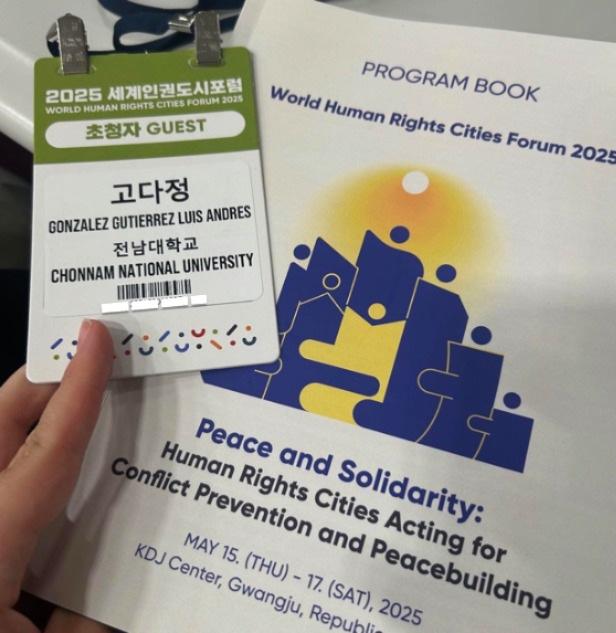

The room was full. Older women, student volunteers, international guests, and local activists gathered to share and witness. The energy was solemn but vivid. The stories were honest – sometimes painful – but offered through voices determined to be heard.
I was especially drawn to this event because I believe the legacy of women in democratic movements deserves more than symbolic recognition; it deserves active, intergenerational dialogue. The session reminded me that the history of May 18 is not only about past resistance but also about how we shape the future through inclusion.
It was in this context that I had the privilege to approach Kim Gyoungrae (김경례), chief executive officer of the Gwangju Foundation for Women and Family (광주여성가족재단), and the moderator of the Forum. In the following interview that I conducted with her, Kim reflects on the relevance of this year’s gathering, the work of the Foundation, and the challenges – and hopes – of making Gwangju a truly inclusive city for all.
Kim Gyoungrae presenting at the World Human Rights Cities Forum.
Luis was there – at the World Human Rights Cities Forum.
Luis: This year’s Forum brought together powerful voices to revisit the role of women in the Gwangju Uprising. Why was it important to host this Forum in 2025?
Kim Gyoungrae: The year 2025 marks the 45th anniversary of the 1980 Gwangju Democratic Uprising. In commemoration, the Gwangju Foundation for Women and Family has been preparing a publication titled “2025: Women and the Gwangju Uprising” since last year. Although 45 years have passed and various materials, such as investigation reports, testimonies, and oral histories, have accumulated, there has been no comprehensive publication focusing on women’s experiences and contributions at that time.
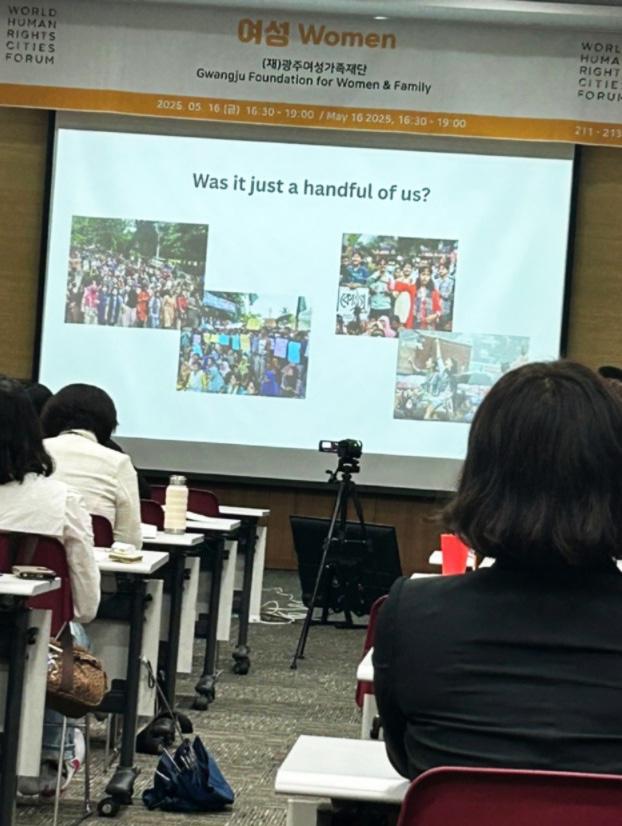
Luis: As the head of the Women’s Foundation, how do you see the importance of documenting women's contributions to democratic movements, especially when they have been historically overlooked?
Kim Gyoungrae: Historical records are influenced by power structures. In history written from the perspective of the privileged –
centering on vested interests, the center, and men – the stories of marginalized groups, including women and regions, have often been excluded. Recording history from the ground up, such as women’s history and local history, is essential for establishing a balanced historical perspective and completing the full picture of the past. Specifically, documenting women’s activities in the democratization movement recognizes them as historical agents and helps future generations inherit a just view of history.
Luis: Gwangju is known as a city of democracy and human rights. In your view, what is the role of the Gwangju Foundation for Women and Family in continuing that legacy today?
Kim Gyoungrae: The Gwangju Foundation for Women and Family is a municipal organization with the mission of achieving gender equality. Gender equality is both a necessary and sufficient condition for the realization of human rights and democracy.
We must build a social system that promotes coexistence, mutual prosperity, and inclusion, while reducing structural discrimination and social polarization. ”
Luis: What are the challenges that you face while promoting the human rights of women and the underprivileged?
Kim Gyoungrae: Around the world, we are witnessing a rise in far-right and conservative movements. In societies dominated by excessive competition, individualism, materialism, and the law of the jungle, there is no room for women or the socially vulnerable. We must build a social system that promotes coexistence, mutual prosperity, and inclusion, while reducing structural discrimination and social polarization.
Luis: As we enter June, a month of reflection and visibility for LGBTQ+ communities worldwide, “
Director Kim’s session on “2025: Women and the Gwangju Uprising.”

how does the Foundation engage with gender and sexual diversity in Gwangju?
Kim Gyoungrae: In pursuit of gender equality, the Foundation conducts research on women’s and family policies, gender impact assessments, gender mainstreaming initiatives, gender equality and gender-based violence prevention education, governance network-building, local women’s history research and public awareness campaigns, operation of the Gwangju Ai Kium (광주아이키움) platform for prenatal, childbirth, and parenting support, and various caregiving support programs. Personally, I support the rights of sexual minorities and the protection of sexual diversity. However, the Foundation’s work primarily focuses on achieving gender equality through research and practical programs.
“
Gender equality is both a necessary and sufficient condition for the realization of human rights and democracy. ”
Luis: What are the Foundation’s upcoming priorities or projects, especially in light of the new administration after the presidential election?
Kim Gyoungrae: President Lee Jae-myung has pledged to restructure the currently marginalized Ministry of Gender Equality and Family into a stronger ministry, reversing the regressions seen under Former President Yoon Suk Yeol. Consequently, we expect strengthened gender equality policies at the local level. Our
Foundation, as an intermediary support body for gender equality at the municipal level, must expand both its size and functions. Most urgently, as gender division fueled by political discourse deepens misogyny among youth, we must broaden policies and programs that improve gender sensitivity and foster mutual respect and a culture of community.
Luis: As a young foreigner living in Gwangju and committed to social justice, I’d love to hear your message to people like me. How can youth and foreigners contribute to Gwangju’s democratic spirit?
Kim Gyoungrae: Human rights, equality, and justice are universal values of our time. The effort to realize these values requires no distinction of nationality or race. There are only global democratic citizens. I firmly believe that global democratic citizens can resist injustice and inequality, and form solidarities across national, racial, ethnic, and gender boundaries.
Luis: To conclude, I want to thank you, Director Kim, for your time, your leadership, and your kindness throughout this interview. I believe readers will not only better understand what the Gwangju Foundation for Women and Family does, but also feel the spirit and care with which you lead it. We’ll certainly be following the Foundation’s next steps, and I look forward to seeing your work continue to inspire Gwangju and beyond.

The Author

Luis Andrés González is a Mexican Global Korea Scholarship scholar and master’s student in cultural anthropology at Chonnam National University. He advocates for LGBTQ+ rights and gender equality, and explores global affairs through pop culture. He is the founder of Erreizando, a digital magazine. Instagram: @luisin97 / @ erreizando
Photographs courtesy of Kim Gyoungrae and Luis Andrés González.
Banner at the World Human Rights Cities Forum.
Sambok, Dog Days, and Bok-darim
By Chung Hyunhwa
In English, the hottest days of the year are called the “dog days,” which is the translation from Latin caniculares dies. The ancient Romans and Greeks thought the greatest summer heat was affected by a very bright star, Sirius, or the “Dog Star,” of the constellation Canis Major (Big Dog), which rises along with the sun during the hottest days of summer. In Korean, the three hottest days of the summer are collectively called “Sambok” (삼복) and are individually referred to as Chobok (초복, the “first bok” day), Jungbok (중복, the “middle bok” day), and Malbok (말복, the “final bok” day). We call each bok day a boknal (복날), and a lot of people keep the tradition of eating bok-darim (복달임, a special treat eaten on each bok-nal). The Chinese character for bok (복, 伏) means to “lie flat” or “lie on the belly,” which suggests that everything surrenders in front of the great summer heat. Interesting also, the Chinese character for bok (伏) is a combination of the radical for “man” on the left and the Chinese character for “dog.”
Regarding the origin of this summer observance, Dongguk-sesigi (동국세시기), a book about customs written during the Joseon Dynasty period, explained that the Sambok tradition started during the Qin Dynasty of China in the 6th century BCE. At that time, according to the record, it was observed by performing a rite with an offering of dog meat to wish for a summer without serious damage from harmful insects to keep the year’s harvest safe. In an agricultural society, it was also reasonable to have such days to encourage nutritious food and rest to keep the people healthy. There is no clear historical evidence, but such tradition must have been adopted in Korea along with the calendar system around the Three Kingdoms Period (8 BCE – 660 CE), when the interaction between Korea and
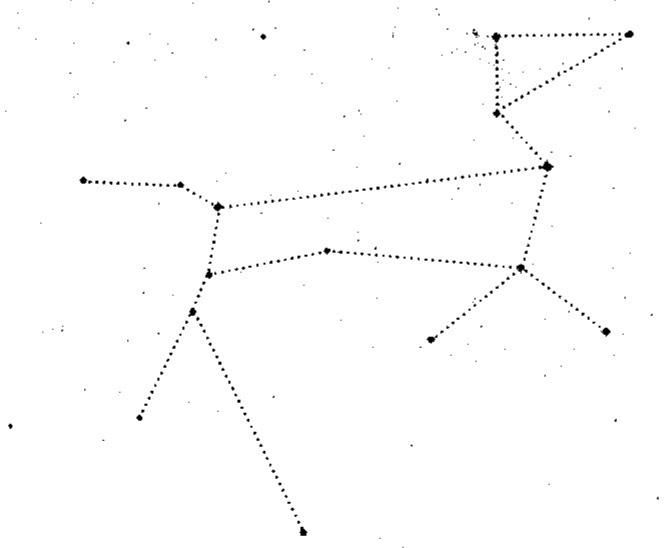
China was frequent. The dates of the three boknal are decided by the 60-year calendar system, making them fall on different solar calendar dates each year, but mostly between mid-July and mid-August.
The idea of Sambok was to pause to find the balance of life by getting rest and eating nutritious foods with family and close friends to protect against the extreme heat, so the historic records show that people would go to a cool place where there was water or shade and eat special foods. Kings of the Joseon Dynasty would grant the imperial gift of beef to the government officials, but the public would commonly get chicken or dog meat because oxen were an important livestock asset in the agrarian society. Red bean soup and watermelon were consumed as well.
In 2025, the Sambok days fall on July 20, July 30, and August 9, ten days apart from each other as usual, but not so surprisingly, this summer is predicted to be hotter than usual. According to the latest BBC news, the polar sea-ice area is decreasing rapidly, and is at the lowest in recorded history. Some scientists predict the ice in the Arctic Ocean will completely disappear by 2030, ten years earlier than the previous predictions. Sea-ice works like a mirror, reflecting the energy from the sun into space, so the decrease in sea-ice will leave the dark-colored oceans to absorb more heat to speed up global warming – which doesn’t sound good. Therefore, taking care of one’s health during the Sambok days may have gained more significance than in the past.
However, due to our threatening climatic situation, we may want to give some thought to the bok-darim food choices to show our awareness. Which foods are good for our health
and, at the same time, have the least effect on climate change? If we aim at releasing less carbon, plant-based foods are the best. Soybeans, soy products, and mushrooms are easy options for protein to replace meat. At the vegetarian level, eggs and cheese are much lower carbon options compared to meat. Among meats, poultry is still the lowest. I notice more and more people choose to reduce meat consumption as an action for the climate problem we have, although eating meat had been a very normal practice in most parts of the world.
Sambok is a nice tradition in many ways, but unlike olden days, we live in a time of abundance, so trying the low-carbon, light-calory alternative bok-darim dishes may be more beneficial healthwise, and it will make you feel good about the environment-friendly choice you make. Thus, how about a dish of a nice low-carbon Sambok treat to observe bok-nal this year? Here are some suggestions for the alternative bok-darim options:

• Mushroom Tofu Soup with/without ginseng (인삼버섯두부탕): A very healthy alternative to samgetang (ginseng chicken soup).

• Chaegejang (채개장, Yukgejang soup without meat). Considered to be temple food.
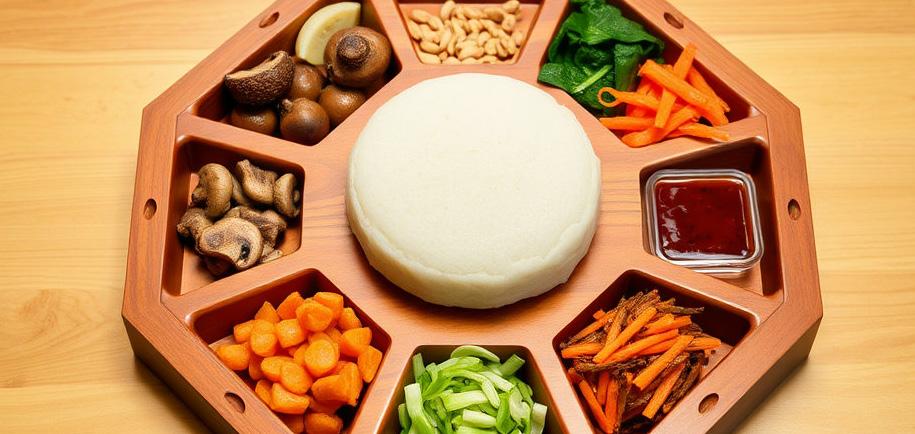
• Miljeonbyeong (밀전병) and Gujeolpan (구절판): Traditional crapes with a “nine delicacy platter.”

• Deulggae Kalguksu (들깨칼국수, noodles with ground perilla seeds): Perilla seeds contain a good amount of omega 3. Using buckwheat noodles (메밀국수) can add all of the essential amino acids.
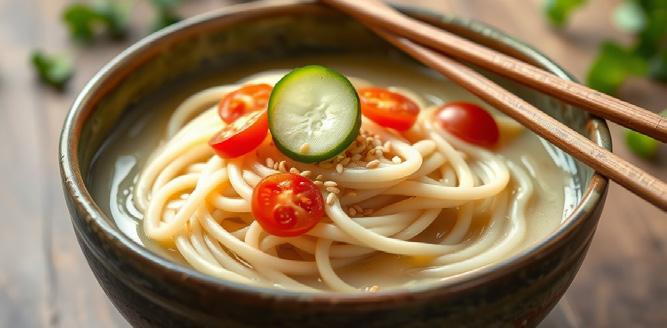
• Kongmul Guksu (콩물국수, Cold Noodles in Soy Bean Soup): A nutritiously balanced choice as a Sambok dish.

• Dubu Kimchi (두부김치, tofu served with kimchi): No-cooking required, zero-efforttaking balanced dish of sliced tofu and kimchi.

The Author

Chung Hyunhwa, a native of Gwangju, recently worked for a horticultural company. She led the international ecohike group Gwangju Hikers at the GIC in 2020 and 2021. Previously, she taught English at Yantai American School and Yantai Korean School in China and worked in school administration at Branksome Hall Asia in Jeju. She holds a master’s degree in TESOL from TCNJ in the U.S. and a license to teach Korean. She loves plants, birds, and repurposing items creatively.

A Festival to Remember Over the Sea, Under the Sun, Into the Mud
By Neha Bisht
Each summer, South Korea bursts into color, rhythm, and laughter – but nothing quite prepares you for the playful chaos of the Boryeong Mud Festival, held on sun-kissed Daecheon Beach. My journey to this iconic event wasn’t just a spontaneous weekend getaway; it was a chance to dive, quite literally, into one of Korea’s most unique cultural experiences. The idea of attending the Boryeong Mud Festival had been on my bucket list since I first heard of it. Originating in 1998 as a clever marketing campaign for Boryeong’s mineral-rich mud cosmetics, it quickly became an international sensation.
Armed with sunscreen, a change of clothes, and a heart full of curiosity, my friends and I set off early in the morning. We booked KTX tickets to Boryeong and, from there, took an intercity bus to Daecheon Beach, where the famous festival was being held. As we got closer, the buzz of excitement grew stronger – colorful banners, happy crowds, and the distant sound of music signaled that we were entering a celebration like no other.
Before diving into the mud madness, we decided to try something I had never done before – sky
biking and zip trekking over the sea. Daecheon Beach is famous for this attraction, and I was both nervous and excited. It was my first time riding a sky bike suspended over the sea, with a stunning panoramic view that stretched endlessly. The sun was blazing, but the staff thoughtfully handed us umbrellas to shield our heads from the intense heat. Pedaling slowly in the sky with the wind in my hair and the sea beneath my feet was simply surreal.

Pedaling through the sky over the waters of Boryeong.
Wristbands on – getting ready to dive into mud madness.
Next came the sky zip trek, and that’s when things got even more thrilling. This was my first time zip trekking, and honestly, I was scared at first. The zip trek was done in pairs, and I could feel my heart pounding as we waited for our turn.
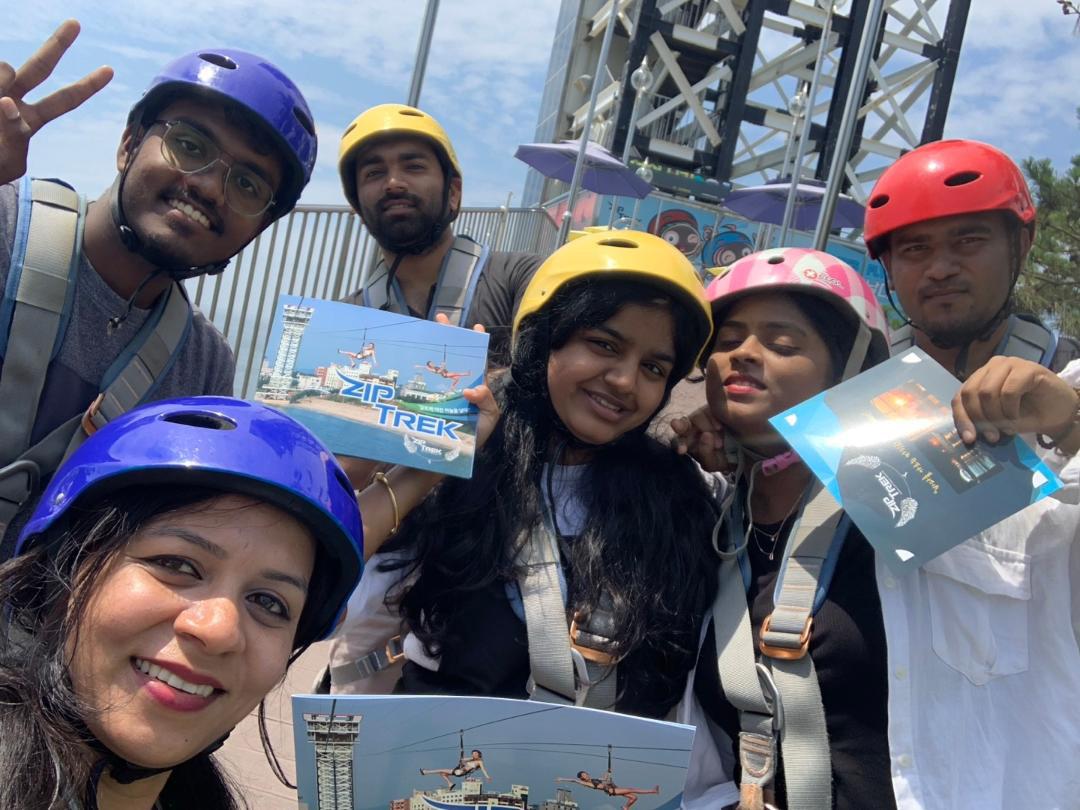
But once they gave us that gentle push, the fear disappeared, replaced by pure excitement! I even managed to record a video of my ride, though I was secretly panicking that my phone might slip from my hand and fall into the sea. But the video turned out amazing – it captured both my screams and the stunning view as my friends and I flew through the air together. After landing, we climbed up to the zip trek tower café on the top floor. Sitting there with a coffee in hand, looking down at the tiny people, boats, and beach below, I felt a quiet sense of joy and accomplishment. It was a moment of peace before the chaos of the mud.
The mud festival was just a short walk away, still on Daecheon Beach. By the time we got there, the festival was already in full swing. We dropped off our belongings in a locker, bought a day-pass wristband, and started roaming around the festival. There were mud pools, mudslides, mud wrestling zones, even mud obstacle courses – all bordered by food stalls, music stages, and cheering crowds. Because we arrived late, we couldn’t try everything, but we still managed to soak up the best parts.
We headed straight to the gray, gooey mud bath, where people were jumping in, rolling around, and throwing mud on each other like carefree kids. On one side, music was blasting and water was being sprayed on those who wanted to rinse off or take a break from the mud. I had never played in mud like this before – it felt oddly liberating. Some people had completely covered their bodies with mud and were sitting quietly, letting the minerals soothe and relax them. We joined in the fun, throwing mud at strangers who soon became our mud buddies. Once they realized how fun it was, they started throwing mud back, and it turned into a hilarious group play session. We laughed so hard that we barely noticed how tired we were getting.
Eventually, we washed off under the water sprinklers, dancing along to the music one last time. Then we explored the rest of the area, where there were water games for both adults and kids. We tried a few – just enough to keep the adrenaline flowing. After all that playing and splashing, hunger hit us hard. We wandered through the festival food stalls, which had a mix of Korean street food and seafood specialties. Everything smelled amazing, and we found ourselves refueling with delicious bites as we chatted about the crazy fun we’d just had.

Geared up for a zip trek to fly over the sea with my friends.
Cheers to sunshine, sea breezes, and sweet drinks with a sky-high view.
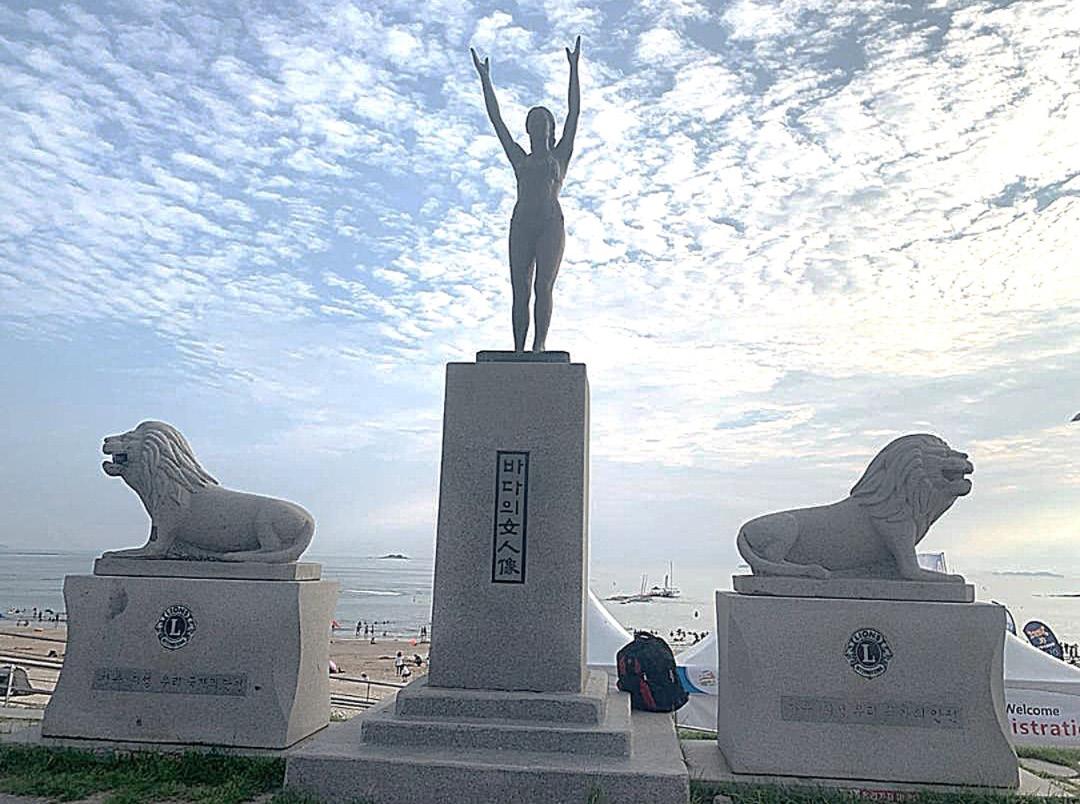
By around 6 p.m., the festival started winding down. Eventually, it was time to rinse off. There were large public showers, and the sight of hundreds of people scrubbing themselves clean was a spectacle in itself. The sun was beginning to set, painting the sky in gold and pink as the waves crashed gently nearby.

After playing, our tired squad at Mud Plaza – from muddy to clean.
Freshly showered and extremely exhausted, we walked barefoot along Daecheon Beach, reflecting on the day, taking photos near monuments, and even playing a bit in the sand. Since it was the last day of the festival, there was going to be a fireworks display at night as the grand closing ceremony. Unfortunately, since we had to return to Gwangju that evening, we missed the fireworks. But honestly, the day had already given us more joy than we could have hoped for.
My trip to the Boryeong Mud Festival was a day full of first-time thrills, mud-soaked laughter, and memories I’ll cherish forever. From trying sky biking and zip trekking for the first time to laughing like kids in a mud bath, every moment was filled with freedom and fun. This incredible festival taught me that sometimes, the best way to feel truly refreshed is to get a little dirty first. Even though we couldn’t see the fireworks, our hearts were already full. And I know that someday, I’ll go back – not just to relive the fun but to create new muddy memories all over again. It became a soft-spoken reminder of stillness, sacredness, and the quiet beauty of slowing down.
Tip: This year the Boryeong Mud Festival is scheduled from July 25 to August 10. Go early in the morning to enjoy the full festival along with the other attractions. Take an extra pair of clothes, slippers, sun protectors, personal toiletries, and towels.

The
Author

A native of India, Neha Bisht is pursuing her PhD research at Chonnam National University’s School of Materials Science and Engineering. She loves to meet new people and make new friends. Neha endeavors to contribute to the wellbeing of society in whatever way she can.
Photographs by Neha Bisht
Out-of-the-Box Things to Do in Summer in Korea
By Dhivyaa S. P.

Looking for a summer escape that’s more than just beaches and cafes?!
Tucked away in the peaceful corner of South Korea’s southwestern coastal islands is a volunteer experience that blends adventure, cultural exchange, and meaningful impact. Last summer, I swapped my research lab hours for salty air and community spirit at the Soan-do Workcamp, a week-long international volunteer program that turned out to be one of the most fulfilling chapters of my life.
A Global Gathering on a Tiny Island
The workcamp brought together 24 volunteers from across the globe, all converging on Soan-do with a shared purpose: to connect with the local
community and contribute to environmental and cultural projects. Our daily routines didn’t just revolve around hard work; they were infused with moments of joy, bonding, and discovery –of each other, of Korean culture, and of ourselves.
Teaching Cultures, Sharing Values
One of the highlights of the camp was spending time with local school children, introducing them to our countries through playful lessons on traditional attire, sports, and customs. The curiosity in their eyes and their excited questions reminded me of how powerful cross-cultural exchange can be, even on a remote island.
We also engaged in a reflective project where we shared quotes on patriotism from historical freedom fighters of our home countries. These deeply personal messages created space for conversations about history, identity, and the values we carry with us across borders.
Giving Back and Breaking Bread Together
The camp wasn’t all about classrooms and conversations. We also got our hands dirty – literally. From cleaning the local beach to scrubbing moss-covered public benches and gardening in the sweltering heat, our days were packed with community service. Though the Korean summer heat came at us in full force with government-issued heatwave warnings, we learned to pace ourselves, stay hydrated, and support one another through every task.
And then came the grand finale: a global food night, where each of us cooked a dish from our home country. Over shared meals, we didn’t just exchange recipes – we shared laughter, stories, and a little piece of home.
Benches turned into storyboards of strength and patriotism.

Friendship in the Unexpected
What truly made the Soan-do Workcamp unforgettable were the small, spontaneous moments. We wrote letters to one another, sealing memories and reflections in envelopes to be treasured later. One of the most unexpectedly delightful activities? Laundry day. Imagine a group of people from different continents, united by the buzz of washing machine and the scent of detergent, laughing together as we sorted clothes. It was simple, lowkey – and completely wonderful.
Lessons from the Tide
For me personally, this camp was a journey of many firsts. I learned to float on water (a major milestone!!!) and even discovered the joy of skipping stones across the sea. It was during those quiet moments on the beach, after a long day of work, that I felt a deep sense of belonging –not just to the group but to a larger world stitched together by shared purpose and open hearts.
Why Should You Consider a Workcamp in Korea?
If you’re spending your summer in Korea and looking for something out of the ordinary, ditch the tourist traps and dive into a workcamp. You’ll not only give back to a community but also gain long-lasting memories and friendships.
The Soan-do Workcamp left me with sun-kissed skin, sore muscles, and a heart full of gratitude.

Warning: Excessive scrubbing may cause sudden dance breaks!
It reminded me that true travel isn’t always about where you go but how deeply you connect –whether that’s with people, with place, or with your own sense of purpose.
Interested
in joining a workcamp in Korea or abroad?
Explore upcoming opportunities and learn more at www.workcamp.org/korea.

The Author
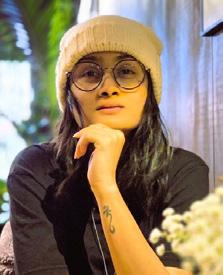
Dhivyaa S. P. believes that every action, no matter how small, contributes to the bigger picture of change. Next up: Under bright lights and loud cheers, she steps into a world of melody, energy, and shared excitement. Stay tuned!
Photographs by Dhivyaa S. P.
Words that stay, even far away.
The Asian Art Garden Where Culture Meets Nature in Gwangju
By Saqib Sharif

Play areas are categorized by their vibrant colors and unique structures.
A New Cultural Landmark Transforms Korea’s Art City
In the heart of Gwangju, South Korea's renowned cultural capital, a remarkable transformation has taken place. What was once a beloved but aging amusement park has been reborn as the Asian Art Garden, a stunning 56,200-square-meter cultural oasis that seamlessly blends art, nature, and community life. Opening its gates in September 2024, this ambitious project represents more than just urban renewal – it’s a bold vision for how cities can integrate culture and nature to create meaningful public spaces.
From Nostalgic Past to Artistic Future
The story of the Asian Art Garden begins with the Jungoe Neighborhood Park, established in 1981 as the Honam region’s first amusement park. For over four decades, families flocked to its rides and attractions, especially during cherry blossom season when the park transformed into a pink wonderland. However, by the 2020s, the aging facilities had outlived their prime, presenting
Gwangju city officials with an opportunity to reimagine this beloved space.
Rather than simply renovating the old attractions, the city embarked on an ambitious 19-billionwon (approximately 14.3 million USD) project that would completely transform the park into something unprecedented in Korea – a comprehensive art garden that celebrated Asian culture while providing modern recreational facilities for all ages.
Three Interconnected Spaces
The Asian Art Garden is thoughtfully divided into three interconnected zones, each offering unique experiences while maintaining thematic coherence throughout the space:
– The Cultural Garden: A Living Gallery
At the heart of the complex lies the Cultural Garden, designed around Asian landscape themes that pay homage to the continent’s rich horticultural traditions. This expansive area
features five distinct garden environments: the Cultural Yard with its sweeping lawns, perfect for gatherings and events; the Grass Garden, showcasing ornamental grasses that dance in the wind; the Dry Garden, inspired by zen philosophy; the Shade Garden, offering respite under carefully selected canopies; and the Rock Garden, which demonstrates the art of stone placement.
“This isn’t merely a children’s play area – it’s an innovative space where environmental education meets creative play.”
The garden’s botanical richness is staggering –over 12,000 trees and 26,000 wildflowers have been carefully planted throughout, creating a living tapestry that changes with the seasons.
Three rest pavilions and a 21-meter-long grandstand provide visitors with comfortable vantage points to appreciate both the natural beauty and integrated art installations, while thoughtfully placed restrooms ensure convenience without disrupting the aesthetic flow.
– The Ecological Art Playground: Where Imagination Takes Flight
Recognizing that great public spaces must serve all generations, the designers created the Ecological Art Playground to replace the former amusement park rides. This isn’t merely a children’s play area – it’s an innovative space where environmental education meets creative play.
The centerpiece is a spectacular nine-meter-tall adventure play structure that challenges young visitors while remaining safely accessible. A salamander-themed water play area celebrates local wildlife while providing cooling relief during Korea’s hot summers. Zip lines add excitement and adventure, while traditional swings offer timeless pleasure. Throughout the playground, art installations spark curiosity and conversation, creating an environment that stimulates all five senses while encouraging imaginative play.
– The Sky Bridge: Connecting Culture and Community
Perhaps the most impressive engineering feat of the entire project is the Sky Bridge – a 347-meter aerial walkway that soars 20 meters above the landscape. This isn’t just a pedestrian convenience; it’s a destination in itself, offering breathtaking panoramic views of Gwangju and connecting the previously separated Gwangju Arts Center with the Gwangju Museum of Art.
The bridge features a remarkable accessibility innovation: a 20-meter elevator that allows visitors of all mobility levels to easily access the walkway. From there, visitors can stroll to the mountain’s summit, experiencing the garden from an entirely new perspective while enjoying one of the best views in the city. This commitment to universal design ensures that the garden truly serves all members of the community.
A Model for Cultural Tourism
The Asian Art Garden represents more than just a successful urban renewal project – it’s positioning Gwangju as a leading destination for cultural tourism in Asia. Kim Jun-ki, director of the Gwangju Museum of Art, envisions the space as a comprehensive cultural landmark where “exhibition, performance, recreation, and play” converge to create experiences that cannot be found elsewhere.
The garden’s integration with existing cultural institutions creates a powerful synergy. Visitors can easily move between the Gwangju Museum of Art, the Gwangju Biennale Hall, and the Arts Center, creating full-day cultural experiences that combine indoor exhibitions with outdoor artistic engagement. This holistic approach to cultural programming sets a new standard for how cities can leverage their cultural assets.
Sustainable Design and Environmental Stewardship
The project’s commitment to environmental sustainability is evident throughout its design. Rather than completely clearing the existing landscape, designers worked with the natural
topography and preserved significant stands of trees wherever possible. The diverse garden environments demonstrate different approaches to sustainable landscaping, from droughtresistant dry gardens to native plant communities that support local wildlife. The integration of water features, including the salamander play area and various fountains, incorporates rainwater management systems that help mitigate urban flooding while creating beautiful focal points.

Sand playspace for toddlers and other children.
Community Impact and Future Vision
The Asian Art Garden’s opening has already begun transforming the surrounding neighborhood. Local businesses are reporting increased foot traffic, and the enhanced cultural infrastructure is attracting new art galleries and creative enterprises to the area. The garden serves as a catalyst for broader cultural district development, potentially rivaling Seoul’s Hongdae or Insadong districts.
Looking forward, the garden is designed to accommodate future expansions and programming. Temporary exhibition spaces can host rotating art installations, while the large lawn areas can accommodate festivals, concerts, and community gatherings. The flexible design ensures that the space will continue evolving to meet changing community needs.
A New Chapter for Gwangju
The Asian Art Garden represents Gwangju’s evolution from a regional cultural center to an internationally recognized destination for art and culture. By investing in high-quality public space that honors both artistic excellence and environmental sustainability, the city has created
something truly special – a place where families can play, artists can create, and communities can gather in an environment that celebrates the best of Asian culture.
For visitors planning to experience this remarkable new destination, the garden offers something for everyone: Art lovers will appreciate the seamless integration of installations with natural beauty, families will find endless entertainment in the playground facilities, and nature enthusiasts will discover new inspiration in the diverse garden environments. Most importantly, the Asian Art Garden demonstrates how thoughtful urban planning can create spaces that enhance both individual well-being and community connection.
As other cities around the world grapple with aging infrastructure and the need for more green space, Gwangju’s Asian Art Garden offers a compelling model for how cultural investment and environmental stewardship can work together to create places that truly enrich urban life. It stands as a testament to the power of visionary thinking and the importance of creating beautiful, accessible public spaces for all to enjoy.

Sources
Bae, K. (2024, September 6). 광주시, 예술·자연 공존 ‘아시아 예술정원’ 7일 개장 (Art and nature coexistence in Gwangju: Asian Art Garden opens on the 7th). Landscape Times. http://latimes.kr/ news/articleView.html?idxno=52397
Lee, H. (2024, September 7). 광주 중외공원에 ‘아시아 예술정원’ 개장 (Asian Art Garden opens in Gwangju’s Jungoe Park). KBC News. https://news. ikbc.co.kr/article/view/kbc202409070026 Pro Yeol-log. (2025, May 13). 운암동 가족 나들이 하늘다리 산책로와 아시아 예술정원 (Unamdong family outing Sky Bridge trail and Asian Art Garden). Naver Blog. https://blog.naver.com/ yeol_log/223863937867
The
Author

Saqib Sharif is a Pakistani national. He earned his PhD at Chonnam National University in February 2024. Currently, he serves as a senior researcher at Shinsung Tech in Gwangju.
Photographs by Saqib Sharif
Heading to Nature for Rest The Mt. Mudeung Literary-Cultural Festival
By Park Yeonju
At an elevation of 1,187 meters, Mt. Mudeung is a strong and dependable mountain protecting Gwangju. It is a place where fresh air and the scent of nature are abundant. This is a UNESCO Global Geopark and a National Park of South Korea. The Mt. Mudeung Literary-Cultural Festival is hosted by Dong-gu, the district where Mt. Mudeung (aka Mudeung-san, 무등산) is located. Currently, Dong-gu is carrying out various programs under the slogan “Literary-Cultural City, Gwangju Dong-gu.” Going beyond merely emphasizing culture and literature, the district is focusing on the values of people and community in its administration, striving to implement the concept of a “people city.” By utilizing Dong-gu’s resources, it is proactively promoting activities among the citizens of Gwangju through a variety of literature- and culture-related programs.
The Mt. Mudeung Festival makes good use of the mountain, Dong-gu’s greatest asset. The Donggu Literary Walking Trail, featuring four walking courses with various themes and stories, and the Dong-gu Literary Hall, featuring books, movies, and food culture, can be experienced in one place. The Dong-gu Literary Hall, Book-Reading Donggu, and other open spaces for communication among citizens have been created to transform Dong-gu into a true literary-cultural city. This festival takes place at a time when the fresh energy of spring still lingers, at the cusp between spring’s end and the start of summer. Each year, the Mt. Mudeung Literary-Cultural Festival is held at Mt. Mudeung. This year May 31 and June 1 marked the third year of the festival, and it has become a major event of the district. Now, let’s revisit this year’s festival, which I enthusiastically
participated in. Join me in heading out to nature for some rest, or “for:rest,” as the event promotes!
The way to the festival was not difficult to navigate. This was because shuttle buses were provided from Hak-dong to make it easier for citizens to enjoy the festival. Buses ran every hour between the Hak-dong Jeongsim Temple Entrance Station and the Mt. Mudeung Jeongsim Temple entrance, with several stops along the way, ensuring smooth travel without consuming much time. The shuttle buses operated from 10 a.m., when the festival began, and ran until around 6 p.m. This shuttlebus service helped bring in many Gwangju citizens to the event.
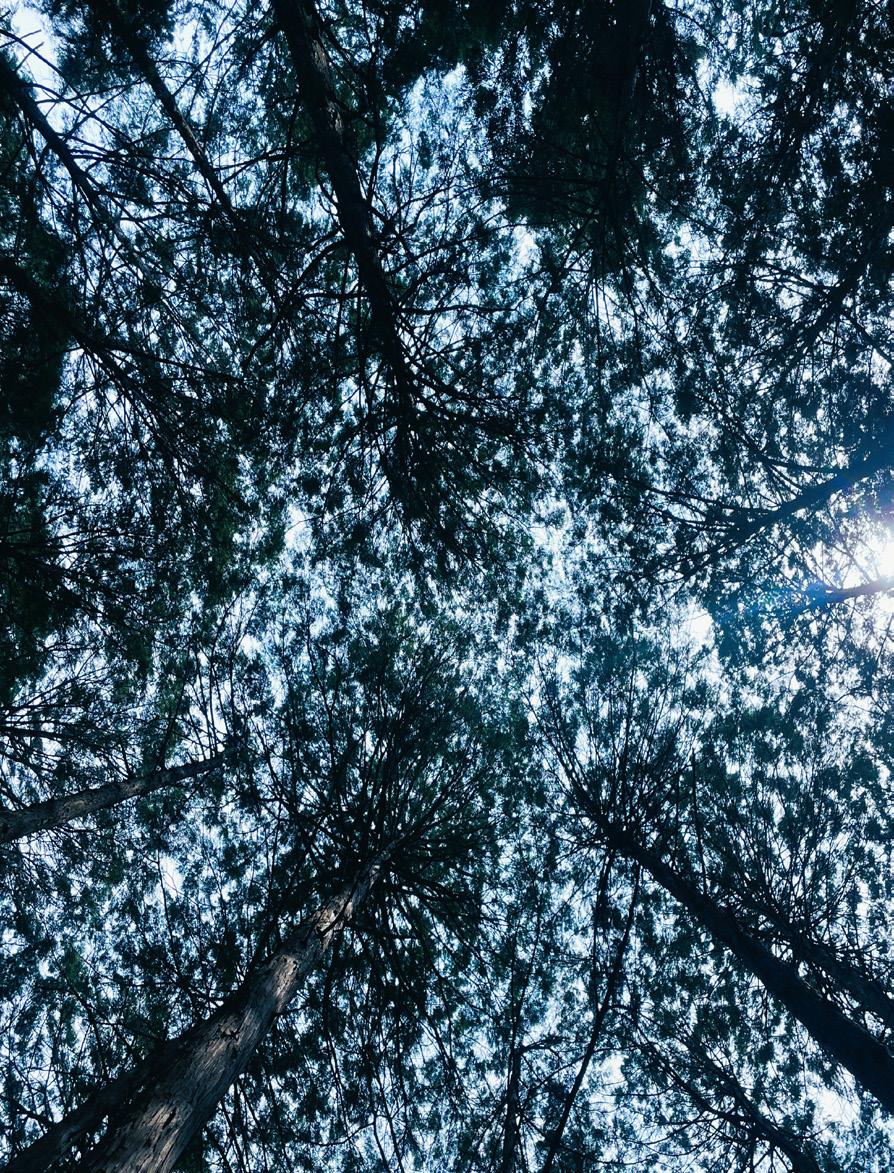
A cypress grove view, looking up.
As soon as I got off at the Jeongsim Temple entrance, a sign reading “UNESCO Global Geopark” caught my eye. It was a new experience to enjoy a festival where both literature and nature could be fully appreciated in a globally recognized park. Although the festival had just begun, many people were already bustling around early in the morning. We could gain plenty of information through Instagram in advance. After visitors walked around the booths and collected all five of the required booth stamps, they could receive festival goods as part of an ongoing event. I picked up a pamphlet at the operations center and began to fully enjoy the festival!
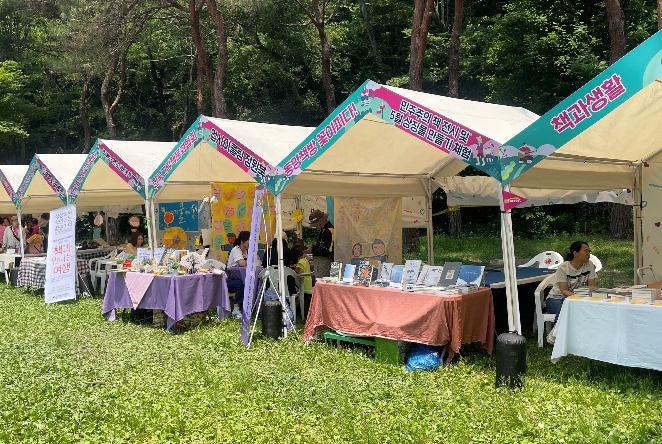
The main feature of the festival was that the event was separated into several zones, each with its own theme. The spacious Mt. Mudeung area, filled with the scent of grass, was divided to offer a variety of experiences. Major events were held at the main stage square, including the opening performance “May Play,” which portrayed Gwangju in May 1980, when the city became one family surviving on rice balls, and the Mt. Mudeung Youth Golden Bell.
The Dong-gu Travel Zone, in front of Munbinjeong Temple, was filled with booths from organizations located in Dong-gu. There were activities such as creating personalized fans through calligraphy hosted by the Lifelong Learning Center, woodblock printing experiences by the May Mudeungsan Stars at the house of poet Moon Byeong-ran, and upcycling experiences at the Dong-gu Literary Hall. Thanks to the citizen participation booths, it was a lively
and engaging zone. The healthcare booth set up by the Dong-gu Health Center offered guidelines on food poisoning prevention, and there were booths utilizing local resources, such as those for the Gwangju Love Donation Program and the Chungjang Festival. It was a zone full of information and variety.
The Literary Pop-up Zone at the cypress forest was an area full of hidden gems, accompanied by the refreshing scent of phytoncides. Although I had visited Mt. Mudeung many times before, this was my first time to visit the cypress grove. It was a space where I could sit in a comfortable chair and fully enjoy the natural sounds in a wooded area filled with cypress trees. In the cypress grove, there were activities like the book camp and book talks with reading clubs from around Gwangju. Some citizens were also enjoying a relaxing weekend, having picnics with their families.
Isn’t the most healing sound the sound of nature?
The “talk concert” took place in a peaceful atmosphere accompanied by the sounds of nature. While feeling the freshness of the grass, a warm and resonating author’s book talk was held. As part of the 2025 Dong-gu Academy Program, the “Book-Reading Dong-gu” author of the year was invited to enrich the event. Over the two days, the audience shared warm, humanistic knowledge. On the nearby lawn, an experience based on the Nobel Prize-winning author Han Kang was taking place. Participants wrote postcards to the author in the Forest of Contemplation, made up of passages from Han Kang’s books. Everyone wrote their own sentences in nature.

The Literary Pop-Up Zone.
A book talk in the cypress grove.
The “book-camping” among the cypress trees was a great time to soothe a tired mind in the midst of the city. Through onsite first-come, first-served registration, participants could receive a free book-camping packet. The package included a book by Lee Geum-i, the author selected as Donggu’s author of the year, organic juice and cookies, a notebook, and a pencil. It also came with a mat, making it possible to enjoy a perfect bookcamping experience without needing to bring anything extra. The Sustainable Development Picnic was held amidst the freshness provided by nature through the book-camping packet.

To reduce the use of disposable items, the festival provided water in reusable cups. From A to Z, the festival aligned with nature, and its planning intentions were meaningful. It was a time to escape the busy sounds of the city and fully experience the sounds of birds and the wind in nature. Lying down and looking up at the sky, the sunlight streaming through the cypress branches calmed both my mind and body. Being able to focus solely on a book, away from the digital world of phones and computers, made for a refreshing weekend. It was a time to forget the things that usually occupy my thoughts and to heal in the warm embrace of the cypress trees.
At the Dong-gu Literary Hall booth, there was a free upcycling activity where citizens could make keychains from sea glass. It was an opportunity to recycle glass and seashells collected from the sea to create beautiful keychains. Through these materials that might have been carelessly
discarded, I was able to craft my own unique piece and realize the value of resources. For the closing performance, there was an orchestra concert using recycled instruments. It was impressive to see resources from nature recycled again and echoing through the natural surroundings. The sounds of birds and wind blended harmoniously, wrapping Mt. Mudeung in a peaceful atmosphere.
On clear days, you can see the towering peak of Mt. Mudeung from all compass directions. The festival allowed me to deeply feel the energy and charm of the majestic mountain, which has always stood strong, protecting Gwangju. At the start of summer, many citizens gathered at Mt. Mudeung, bringing new vitality to the mountain. The festival was a time to experience the beauty of literature, the arts, and the unique joys of nature based on sustainable development. If you want to feel the comfort that nature offers in its purest form, head to Mt. Mudeung in Gwangju’s Dong-gu.



Park Yeonju is an undergraduate at Chonnam National University, majoring in political science and diplomacy as well as Chinese language and literature. Her third major is international development cooperation studies. She was born and raised in Gwangju and wants to promote the colorfulness of the city that she has been a part of for so long.
Photographs by Park Yeonju.
The Author
The outdoor Mt. Mudeung library.
The Mudeungsan UNESCO Global Geopark sign.
Diaspora Communities A Social Anchor in a Foreign Land
By Arum Ayuningsih
For many people who move to a new country, the first place they turn to for guidance, stories, or simply a sense of familiarity is often not an official institution but rather fellow diaspora members who have already navigated the challenges of settling in.
In a new place like South Korea, where the language, food, and culture are different from what we are used to, newcomers often find themselves unsure of whom to ask for help. I still remember my first days in Gwangju. With minimal Korean language skills, I relied on Google Translate to communicate. However, the translations were often inaccurate, leading to further confusion. Fortunately, I encountered a fellow Indonesian who kindly helped. A friend of mine also went through a similar experience; he was unsure how to renew his passport or even how to adjust the room heater in his oneroom as winter approached. In moments of such disarray, the sincere support of those who have “been there” before becomes invaluable, not just practically but emotionally as well.
I found the diaspora communities to be incredibly helpful during the early stages of adjustment. The conversations were often casual, such as sharing dinner invitations, offering shopping tips, or discussing everyday campus experiences, but they proved to be essential. For new arrivals, these chats serve as a source of practical information, emotional support, and the foundation for new social connections. On several occasions, the chat room also served as an information hub for official announcements, including Ramadhan schedules, community events, and even outreach related to overseas voting procedures for presidential

elections. Behind these small, everyday gestures lies a spirit of collective care that, at times, proves more effective than institutional support. Empathy grows from shared experiences, and concern arises unprompted. In my opinion, this is a genuine solidarity in its most authentic form, when someone who was once lost becomes the one who lights the way for others.
Beyond supporting newcomers, diaspora communities also serve as spaces to nurture identity, share values, and rediscover a sense of belonging amidst cultural dislocation. In every gathering, whether formal or spontaneous, there is a quiet effort to stay connected to our cultural roots without shutting ourselves off from
Useful info shared through the diaspora group chat –helping newcomers with legal, admin, tax, and health issues, all in one place.
the new environment – from small things like speaking our native language and shared meals to participation in international cultural festivals. Through this community, we not only sustain communication and emotional well-being in a foreign land but also strive to represent our culture proudly. Thus, it is not only a support system or source of mutual solidarity but also a cultural bridge, opening spaces for dialogue and introducing our traditions, food, and arts to international audiences. These moments serve as a reminder that, although we live far from home, our identities remain intact. Instead, they evolve into new forms that are more open and more interconnected. Behind the laughter and familiar aromas lies a story of resilience, adaptation, and pride woven together by those who share the experience of migration.
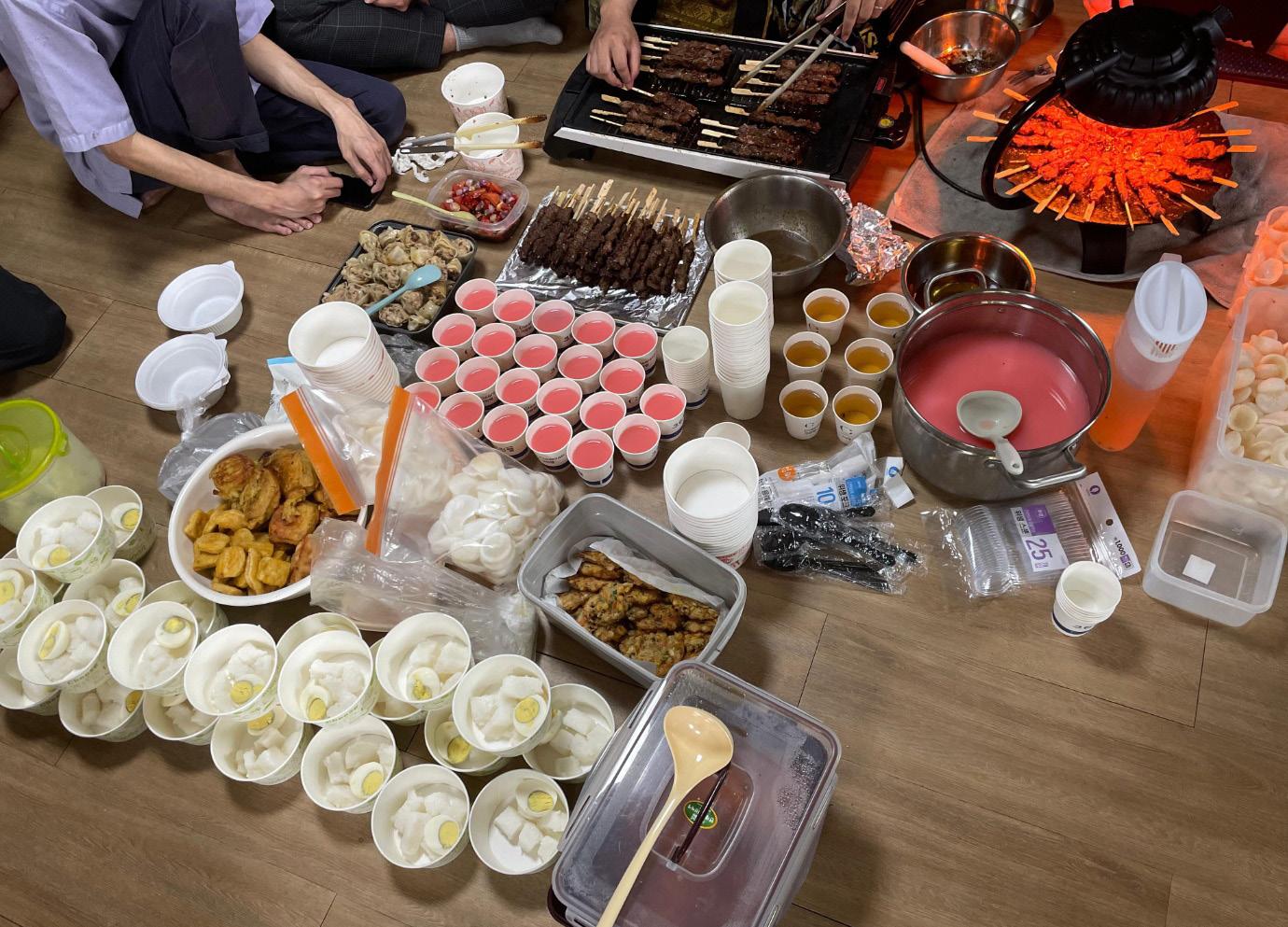
Sharing food, stories, and a sense of home. A simple meal becomes a moment of connection for the diaspora.
Like any other social group, however, diaspora communities are not without their internal challenges. Not all members engage equally; some are active and open, while others remain passive or only appear when they need something. There are moments when discussions in the group chat lose direction, shifting toward off-topic exchanges or touching on sensitive issues that unintentionally create friction among members. There may be discomfort due to differences in background, communication styles, or subtle comparisons between members. If not managed carefully, what once was an inclusive space can easily become a setting where some feel left out or
alienated. To maintain a healthy and welcoming environment, it is essential to encourage active listening, share responsibilities through rotation, and strengthen offline bonds through regular gatherings. These efforts can foster open, yet respectful dialogue, which helps to ensure that the community remains a supportive and inclusive space for everyone, regardless of how long they’ve been part of it.
“Diaspora communities are not only spaces for sharing but also vital channels for strengthening participation and engagement in one’s new life abroad.”
These experiences have made me realize that a diaspora community is not just about gathering with fellow nationals. It can be a space for growth, mutual understanding, and collective goodness. In a world that moves fast and leans toward individualism, diaspora communities remind us that we don’t have to adapt alone. There are always helping hands, if only we are brave enough to reach out and open enough to be touched. Furthermore, such communities also play a crucial role in facilitating communication between diaspora individuals and formal institutions. Through informal networks built on trust and solidarity, important information can be distributed more quickly, widely, and accessibly. In many ways, diaspora communities are not only spaces for sharing but also vital channels for strengthening participation and engagement in one’s new life abroad.

The
Author

A. Ayuningsih is a graduate student seeking to express the concerns she observes in her surroundings. She hopes that her words may raise awareness and offer a meaningful contribution to the broader community and society in which she lives.
Photographs by A. Ayuningsih
Unnie’s Nail Salon Affordable Gel Nails in Gwangju
By Maryam Ali
Iwas having a conversation with a friend, comparing the pricing of gel nails between Busan and Gwangju. That’s when I realized what a gem Unnie’s Nail Salon is.
“It was about 20,000 Korean won for the deposit, and I think 15,000 for the plain colored nails.”
“35,000 won?”
“Yes.”
“How affordable!”

Unnie’s Nail Salon is located in the heart of Ssangchon-dong. I first found this place from a friend who loves gel nails. She visited this specific salon a couple of times after having an issue with another salon for inconsistent service. She found Unnie’s Nail Salon by scouring the mobile app Naver Map. After finding the Instagram images consistent and stylish, she gave it a shot. It became her go-to place in Gwangju to get her nails done.
She was raving about how her nails had grown so long, and she hadn’t been able to have long, healthy nails in her home country. I decided to try the service myself to figure out what she was raving about. I came to have a similar experience, visiting the salon often myself.
Services
The easiest way to book the service is through Naver. Naver as a service acts as the middleman to book your reservation (ye-yak, 예약). You can access this through the Naver Map app. Once you press the “book” button, you have the option of three nail artists. All are talented at their craft and produce good quality nails. I can vouch that they try their best to produce quality service. Once you’ve chosen one of the nail artists. You can choose the date and time for your reservation. The salon is open Monday through Sunday, 10:00 a.m. to 9:00 p.m. However, bookings are capped to sessions between 10:00 a.m. and 7:30 p.m. After your date is chosen, the list of services on offer is listed.
List of Services
If you have hand gel nails, you must choose one of these two options or your booking could be refunded, as this is how the salon distributes the times for the sessions:
• Hand gel removal: “Ta shop” outside Unnie’s shop; 20,000 won (estimated 15 minutes)
• Hand gel removal: “Ja shop” from Unnie’s shop; 0 won (estimated 15 minutes)
Nail Styles
There are many nail styles offered at this salon. All the treatments listed have an estimated time
Entrance of Unnie’s Nail Salon.
and price. My personal preference is the colored hand gel. The hand gel is offered in one or two colors. The treatment time is roughly 1 hour and 20 minutes. Priced at 35,000 won. The nail salon offers a wide range of services – from son gel (gradient nails) to French hand gel, an art-of-themonth nail set, nail sets for men, and custom nail sets. If you’d like custom nails, make sure to tick the right options in the nail treatment section, as the duration of the treatment can be affected by your choice. It ensures there is enough time in your appointment for the nails to be customized to your preference.

Deposit Required
You select the service of your choice, and you receive a message usually through a text messaging service. From this message, you must send a 20,000 won deposit to the selected bank to confirm your booking. The rest of the price of the nails can be paid in person.
Visit to the Salon
The service is located on the top floor of the building. You must take the stairs to reach the salon if you visit. Once you arrive you must remove your shoes. It’s common practice in Korea to remove your shoes at the door, the slippers are provided by the salon. If there is no wait time you can confirm your booking and sit with the nail artist providing your service. They prep your nails, ask you about your design preferences and allocate the time accordingly. The nail artist only speaks Korean. I’ve been able to get by with my limited Korean. If you need to explain a concept,
Papago is always helpful. You can also use reference photos. The staff are accommodating and open to finding a way to make you enjoy the service. I like how personable the shop is. They often switch the subtitles to English when I enter and are happy to adjust the style to my preference as long as the time permits it. If you’re interested in getting your nails done in Gwangju. Unnie’s Nail Salon is the place to go!


Gwangju Ssong Unnie’s Nail, Ssangchon Branch (광주쏭언니네일 쌍촌점)
Open: Monday–Sunday, 10:00 a.m. to 9:00 p.m.
Address: 2F, 55 Ssangchon-ro 2-1 (989-2 Ssangchon-dong), Seo-gu, Gwangju (광주 서구 쌍촌로 55, 2-1호, 2층)
Instagram: https://www.instgram.com/ ssong_unnienailsc?igsh=MWNzcm81bGJ yMHViMA== Phone: 0507-1479-2136
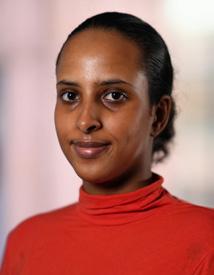
The Author Maryam Ali is currently based in Gwangju. Originally from London, she took the plunge to live abroad and share her experiences in a blog. As a budding journalist, she expresses her fascination with culture, aspiring to understand the world around her. Website: https://sites.google.com/view/maryamaliportfolio/homepage
Photographs by Maryam Ali.
My nails being prepped in the nail salon.
Final design from the nail salon. I chose yellow nails for this trip.
Experiencing Together Day
By Jennah Dabrowski
Ihave almost completed my two-semester-long exchange experience in South Korea, with my first semester being at Chonnam National University in Gwangju and my second at Yonsei University in Seoul, and it has been nothing short of incredible. I was able to join UNESCO KONA volunteers at the English Center last semester to help with English reading and comprehension practice, and have been attending weekly zoom meetings now that I can no longer volunteer in person. However, I came back to Gwangju on May 24 to experience Together Day 2025! I arrived in Gwangju early in the morning and visited the May 18 Memorial and Mugak Temple. Hearing the testimonies and experiences of those who lived through the Gwangju Uprising of 1980 made the visit all the more impactful and gave me perspectives I would have never been able to learn otherwise.
Once we arrived at Gwangju City Hall, I was amazed by the number of people who were attending the event. So many families with children of all ages and many international participants from all over the world were gathered inside and outside the City Hall venue. We walked past the booths that had been set up, and I got to hear about different city policies that were being proposed and voted on by members of the community. So many different countries were represented in activity booths, with games, art projects, and presentations available for the kids and visitors present. I was able to try different foods from countries all over the world and meet many members of the international community in Gwangju. As a KONA volunteer, I got to work with students on English reading practice and listen to their Korean folktale presentations.
For English reading, I shared some American folktales and stories like Johnny Appleseed as well as the history of the Statue of Liberty. The
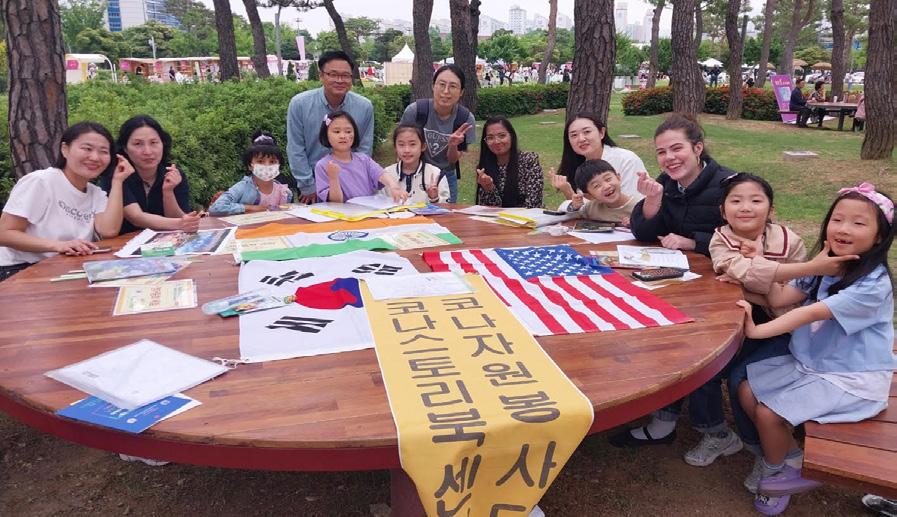
Jennah with the KONA Storybook Center students and their families.
students also presented the Korean folktales they had been practicing and incorporated character cutouts to act out the stories they were telling. Being able to exchange stories between cultures is one of the reasons why I love working with kids.
As my exchange experience comes to an end, I have had time to reflect on this past year, and I have been truly blessed with everything I have been given. Even though the United States is relatively diverse, I had not had the chance to be exposed to another culture firsthand, and I am so grateful for all of the people I have met who have shared Korean culture with me and gone out of their way to help me during my time here. From shared lunches and guided memorial tours to opportunities to visit schools and meet local leaders, I have been given so many Korean experiences that will forever remain a part of me.

The
Author
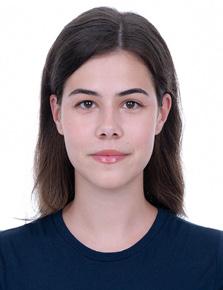
Jennah Dabrowski is an American undergraduate student majoring in biology at the University of Alabama. She has spent the past two semesters studying in South Korea at Chonnam National University and Yonsei University, and has been volunteering with the UNESCO KONA volunteers of the KONA Storybook Center both in person and on Zoom.
Photograph courtesy of the KONA Storybook Center.
When Rain Clouds Gather
Reviewed by Michael Attard
When Rain Clouds Gather
By Bessie Head
186 Pages, Waveland Press, 2013 (Original 1968)
ISBN-13: 978-1478607595
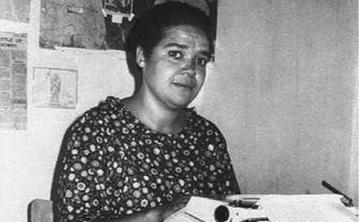
When Rain Clouds Gather was first published in 1968 when apartheid was the ruling political and social system in the country of South Africa. It was not until the early 1990s that this oppressive system was at least legally ended. The author, Bessie Head, was born in South Africa in 1937. Her mother was white and her father black. She took up permanent exile in neighboring Botswana, where she eventually gained citizenship.
This short novel succinctly addresses the historical, social, cultural, political, and economic tribulations facing the continent of Africa in general, both in the past and today. The author is objective in her assessments and offers hope for a better tomorrow.
The protagonist’s name is Makhaya, and he is a South African political refugee. By page 5, he has
reached, somewhat, “safer” ground in Botswana. While Makhaya is a man replete with conflict, he has an “outer air of calm, lonely self-containment.” The author tells us that we only perceive a “sense of this inner discord through the manner in which he averts his glance.” But ultimately, he is a focused man, wanting simply to live free.
“This short novel succinctly addresses the historical, social, cultural, political, and economic tribulations facing the continent of Africa.”
The role and power of tribalism is a major theme. Makhaya is not a tribalist, but his parents are. This underscores the generational divide. Chief Matenge, the antagonist, uses tribalism for his personal gain. The author does not couch her opinions. Through the character, Gilbert, an Englishman working to improve the agriculture in Botswana, we are told more about Chief Matenge: “An extremely cunning and evil mind, a mind so profoundly clever as to make the innocent believe they are responsible for the evil.
Makhaya and Gilbert share similarities. Gilbert hires Makhaya, as “he needed, more than anything, someone with the necessary mental and emotional alienation from tribalism to help him accomplish what he had in mind.” To be clear, for the author, most white men were not like Gilbert. Referring to tribalism, the author says, “And all this had been highly praised by the colonialists as the only system that would keep the fearful, unwieldly, incomprehensible population of natives in its place.”
Bessie Head (1937-1986), writer of novels, short fiction, and autobiographical novels. (Khama III Memorial Museum Archives)

There are several strong women characters, one of whom is Paulina. Only with her influence would it be possible to convince the women to accept Gilbert’s plans. Amongst themselves, there were many intrigues. But it wasn’t these that Paulina feared. Rather it was “the untrustworthiness of men with no strength or moral values.” It was a society of “degenerate men,” whose “superiority in law” negatively “affected them as individuals.” The social and cultural inequalities between the sexes is an ongoing theme.
There are philosophical discussions. Another of the strong female characters is the older Mma-Millipede. She is a Christian woman and invites Makhaya to her home. Makhaya asks her, “What is faith, Mama?” She replies that “it is an understanding of life.” For Makhaya, her response brings neither comprehension nor
peace. For him, “life is only torture and torment … and not something I care to understand.” But where they do agree is on the need for “generosity of mind and soul.” Although for Makhaya, this has nothing to do with Christianity. For him, there are too many apparent contradictions, and “all the lies Western civilization had told in the name of Jesus” were a crime.
“The social and cultural inequalities between the sexes is an ongoing theme.”
Regardless of seemingly endless up and down struggles, the small village within which this story takes place is destined for positive change. “There were too many independent-minded people there, and tragedies of life had liberated them from the environmental control of the tribe.” There would always be droughts, but people could learn to survive those bad years.
Within the story there is death and sadness, and the author’s writing ability casts the reader into the heart of the palpable emptiness. She states, “Death was like trying to clutch the air, and you had to let it be and slowly let it pass aside.”
However, this is a story of hope. So, one must not focus on the death. “Instead, you had to concentrate the mind on all that was still alive and treat it as the most precious treasure you had ever been given.” There will always be struggle, but in a final analogy, the author depicts this fight as the pushing against a heavy door that will not open, only to find that after determined effort, the door is no longer there.

The Author

Michael Attard is a Canadian citizen but has lived in Gwangju for over twenty years. He has taught English as a second language in academies and within the public school system. He is officially retired and spends time reading, writing, hiking, and spending time with friends.
Michael’s copy of When Rain Clouds Gather. (Michael Attard)
Gwangju’s Hidden Gem A Cozy Place for Tea Lovers
By Anne Nguyen
A Popular Spot in a Charming Neighborhood
Dongmyeong-dong in Gwangju is already known as one of the city’s most popular areas. With its small, pretty cafés and tasty restaurants, it is a favorite place for couples on dates, as well as friends and families looking for a relaxed day out. One café that really stands out in this neighborhood is Tea At Café, a tea-focused café that offers something a little more special than your average coffee shop.
A Place for Tea Lovers
As soon as you hear the name Tea At Café, you think of tea, and that is exactly what this café is all about. They bring in their own black tea from overseas and use it to make unique and flavorful drinks. One of their most popular menu items is the Tea At Black Tea Latte. This drink is more than just tea with milk. It comes topped with a scoop of black tea flavored ice cream, making it both beautiful and delicious. The drink has a rich, deep tea flavor, softened by creamy milk, and the ice cream slowly melts, adding more sweetness and aroma with each sip. It is a drink that changes as you enjoy it.
Warm and Relaxing Atmosphere
The interior of the café is just as impressive as the drinks. The space is spread over two floors. The first floor has regular tables and chairs, while the second floor offers a cozy floor seating area where you take off your shoes, just like in a traditional Korean tea room. The warm lights and quiet setting make it a great place to relax, read, or chat with someone special. Whether you are there alone or with company, it feels welcoming and peaceful.

Rustic stone café with warm lights and wooden beams.

There is also a small outdoor space with tables and photo spots, perfect for anyone who enjoys taking pictures or sitting in the fresh air. The café is often full, and it is easy to see why. Great drinks, a calm mood, and kind service make it a place people want to return to.
One nice touch is that every drink comes with a small almond cookie. At first, it might seem like a simple extra, but the sweet and nutty taste goes really well with the tea. Near the counter, you can also buy tea leaves to take home. The tea is displayed in small glass jars, and you can smell them before choosing which one you want.
Final Thoughts
Tea At Café is a lovely place to take a break in the middle of your day. With high quality tea, a cozy setting, and thoughtful service, it offers more than just a drink. It offers a moment of peace. If you are in Gwangju and enjoy tea or simply want to try something new, this is a spot worth visiting.

Tea At Café (티앗)
Address: 12 Dongmyeong-ro 14-beon-gil, Dong-gu, Gwangju
Hours: 12:00 to 10:00 p.m. (Last order at 9:40 p.m.)
Nearest Subway Station: Culture Complex Station, Exit 4 (About 650 meters away)
Parking: No parking on site. Street or nearby church parking is available.
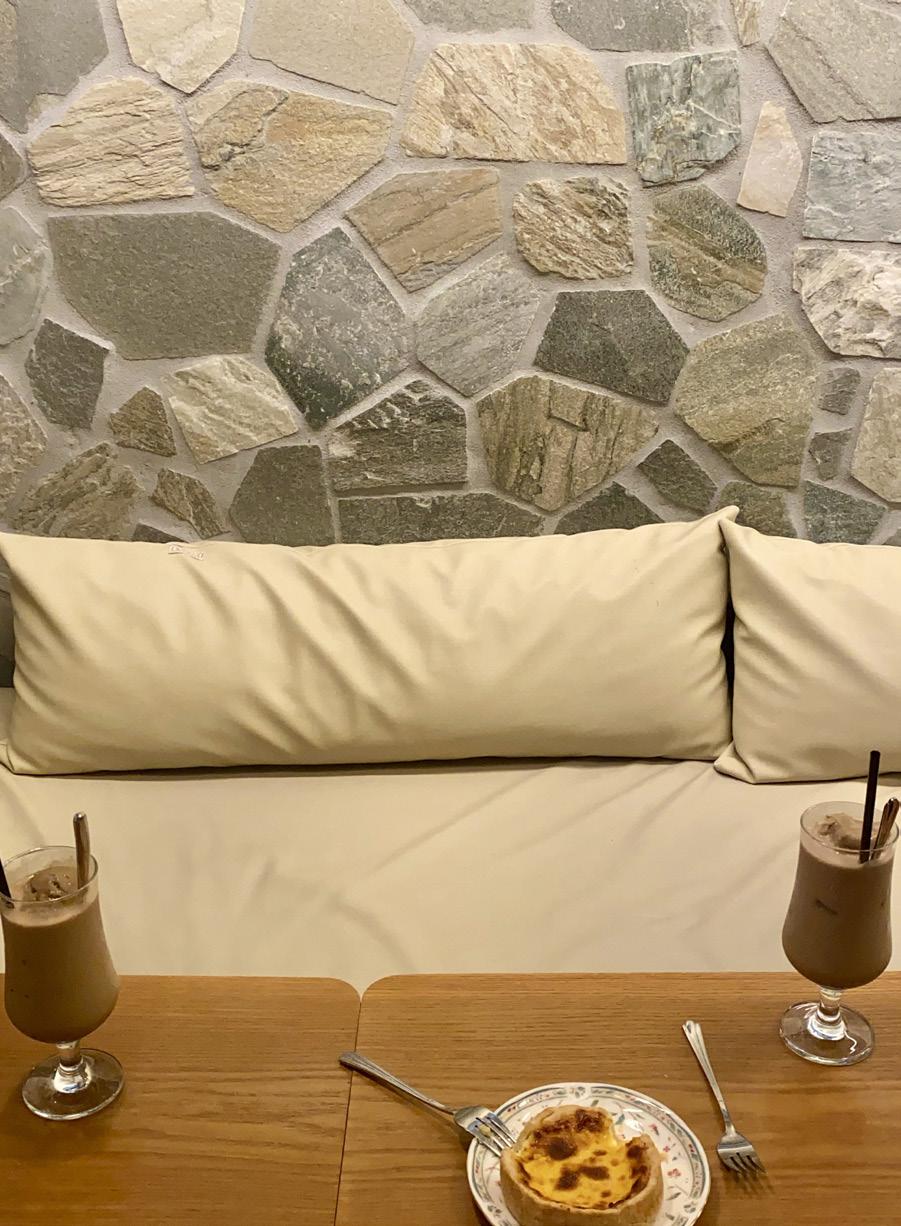
The Author

Anh Nguyen (Anne) has been living in Gwangju for five years studying journalism and communication at Chosun University. She fell in love with the city’s beautiful views, rich history, diverse culture, and delicious food. Her goal is to share her love for Gwangju and introduce its stunning natural scenery and attractions to everyone.
Photographs by Anne Nguyen
Tea At signature Black Tea Latte and a custard tart.
A warm and inviting interior setting at Tea At Café.
Bread, Roses, and Community A Gwangju Bakery Rises Beyond Business
By Yousra Feriel Drioua

In a small Gwangju bakery, flour and activism ferment side by side. Bread and Roses is redefining what it means to be a local bakery. Aiming to balance ethical sourcing and community participation, the founders see the name “Bread and Roses” as a reflection of their mission to combine fair labor practices with a commitment to dignity. This bakery is a place where baking becomes a tool for social change.
Beyond Baking: A Space for Participation
Bread and Roses draws its name from the historic slogan born in the 1908 New York strike of women textile workers demanding not just fair wages, symbolized by bread, but also dignity and a life worth living, symbolized by roses. That rallying call still echoes inside this small bakery. True to its name, Bread and Roses extends its
impact beyond baking. Every March 8, the bakery closes its doors to join a protest march, linking bread with the legacy of labor rights and feminist activism. From workshops on International Women’s Day to film screenings on feminism, ecology, and slow living, the bakery fosters a culture of dialogue and community-building.
“‘We want bread, and roses too!’ – We wanted to create a space where that slogan could be lived out,” said the owners. “There are days when the labor of making and selling bread is so exhausting, it feels like the roses disappear. But whenever customers visit wearing feminism or rainbow badges, it reminds us that people support the values we stand for. We feel proud. Every March 8, we prepare time to commemorate and celebrate International Women’s Day with solidarity events, from workshops and lectures to performances and street marches.” That blend of symbolism and action shapes not just the name, but the bakery’s atmosphere – one where feminist values, transparency, and social imagination are baked into its identity.
The bakery’s philosophy emphasizes that slow, mindful production and community-driven activities can coexist with a sustainable business model. “Because we talk about more than just bread; we talk about the roses too. We ended up organizing all sorts of cultural events,” the owners said. “We called it ‘Rose Time’, a moment to share and learn together. From tea parties and dumpling-making sessions to film screenings, lectures, play readings, and performances, we’ve tried it all. These days, after relocating to downtown, so many great events now take place regularly at nearby spaces like Gwangju Theater (광주극장), Sonyeonui Seo (소년의 서), This Is Not a Bookstore (이것은 서점이 아니다), and
The entrance to Bread and Roses in Gwangju.
Han Georeum Store (한걸음가게). So now, Bread and Roses mostly goes big only on Women’s Day. Haha!”
A Commitment to Ethical Practices
Unlike conventional bakeries, Bread and Roses prioritizes local, transparent sourcing and slow fermentation. The team uses flour from farmers they know by name in Buan, naturally ferments each loaf, and avoids additives and animal products, staying true to their vision of responsible and sustainable baking. Seasonal produce from local farmers becomes jam, carrot salad, or even pizza toppings, deepening ties between the bakery and the agricultural community. But behind every rustic loaf is a labor-intensive routine.
“It takes two to three days for a single loaf of bread to be ready. Bread may be “slow” food, but making it means moving fast. I wake up at 5 a.m. and arrive at the bakery by 6. First, I

feed the sourdough starter and shape the dough that was prepared the day before. Once the oven is preheated, I bake cookies and kkamppanyu (깜빠뉴, pain de compagne, “country bread”), then I work through the batches of dough that have completed secondary fermentation. By 10:30 a.m., we open for business. From that moment on, I’m already prepping dough for the next day, using the starter I fed that morning. I finish around 4 p.m.,” the owner said.
“It never feels slow, there’s just too much to do. The work is hard, especially in summer when I’m standing near a 270-degree oven. But when the dough rises just right, turning golden and filling the air with that heavenly, nutty aroma, I can’t help but think: ‘I’m a bread person through and through.’ The joy of a perfectly baked loaf and the pride of providing nourishing food keep me going.”
The owners have called the bakery a “space of resistance and community,” a sentiment that underscores their commitment to fostering meaningful connections among customers, neighbors, and activists. But creating such a space has not been without challenges. “I don’t even remember saying something that cool,” they laughed. “Sometimes I wonder if we’re really living up to that description. But I guess we used the word ‘resistance’ because we wanted to create a crack in the system, something not driven by profit or capitalist logic. And as for ‘community’, we don’t mean only intimate, tight-knit ties. We want a transparent, safe space where anyone can exist just as they are.”
“Running a space like this means constantly juggling what you want to do and what you have to do. Often, daily survival takes over. For me, rest is essential. When I’m drained mentally and physically, I take a break like it’s school vacation. I visit spaces I’ve long wanted to see and meet people I’ve been meaning to meet. Those moments help me dream again.”
As they continue to knead together activism and entrepreneurship, the owners envision new
The Bread & Roses film poster, honoring its activist roots.
projects that strengthen both collective space and craft. They dream of expanding collaborations and experimenting with new ideas. “Honestly, continuing as we are now would already be enough,” they said. “But I do hope Bread and Roses becomes even more woven into people’s everyday lives. I imagine someone catching a movie at the theater next door, grabbing bread for the week from us, picking up a new book from the local bookstore, and getting refill detergent from Han Georeum. We’re thinking about ways to expand and collaborate more with these neighboring spaces.”

Looking Ahead
Running a bakery with a strong activist identity also means grappling with financial realities and sustainable operations. The owners remain mindful of how to practice slow, ethical food culture while keeping the business afloat. “It’s always tough balancing activism and business. I’m never quite sure if I’m doing it right. It feels like a high-wire act,” they admitted. “But trying to align our beliefs with our business seems to have brought us encouragement and support from others. I think that’s helped us keep going.” They added, “It’s also important to make money sustainably. I want to pay myself a fair salary, so
I don’t feel shortchanged. Above all, our bread must taste good. We put a lot of effort into using high-quality ingredients and maintaining great flavor. That’s how we keep customers coming back.”
For the expat community and anyone curious about sustainable spaces in Korea, Bread and Roses offers more than just bread, it’s an invitation to participate, to connect, and to share in a vision of dignity and solidarity. “We’re only open Thursday through Saturday because we believe in a life with roses. Please keep that in mind if you plan to visit,” they said. “And make it a full experience, catch a film at the theater next door, too! We don’t make sweet bread here. We focus on wholesome, hearty loaves that can be a meal. If you’re missing the bread from back home, you might find something comforting here.”
In Gwangju, Bread and Roses is a testament to the idea that every bite can carry a message, and every small business can rise as a catalyst for community and change.

Bread and Roses / 베이커리
Address: 8 Chungjang-ro 46-beon-gil (Chungjang-ro 5-ga), Dong-gu, Gwangju (광주 동구 충장로46번길 8 (충장로 5가)
Days & Hours: Thursdays, Fridays, & Saturdays, 10:30 a.m. – 6 p.m.
Phone: 062-945-6594
Internet: https://m.blog.naver.com/summer_ bell_/223282791025
The Author
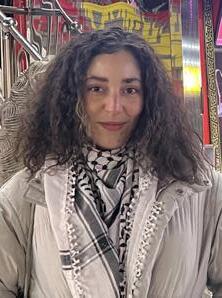
Yousra Feriel Drioua is a freelance journalist and media enthusiast from Algeria currently based in South Korea. A former GKS scholar, she holds an MA in media and communication, and writes on issues at the intersection of gender, media framing, sociopolitics, and civic society. In her free time, she enjoys being a barista! Instagram: myyilgi
Photographs by Yousra Feriel Drioua
Pain de campagne and iced coffee, served simply.
Sorok-do Island of Agony
By Park Nahm-Sheik
This article is meant to be a sad trip down our collective memory lane. Covering an area of close to five square kilometers, Sorok-do is a moderate-sized island in Goheung County on the southwestern extremity of the Korean Peninsula. So-rok-do means “little-deerisland.” It is a mere five minutes by ferry from the port of Nokdong in Goheung County. Since 2007, however, it’s been readily accessible by land via the 1,116-meter-long Sorok Bridge.
Around the closing years of the Korean Empire (1897–1910), American Protestant missionaries started their incursion into Korea. Their activities centered around major cities like Pyeongyang, Seoul, Daegu, and Busan. Among other things, they set up modern secondary schools, playing a major role in modernizing the educational system in the country. However, one remote location receiving missionary assistance was a facility set up on Sorok-do for people with Hansen’s disease (aka leprosy) by the Japanese colonial government in 1916.
Topping the challenges of creating a Hansen’s disease colony in this out-of-the-way area of the country was the relocation of the locality’s native population to somewhere else nearby. The resulting movement of the legions of villagers posed a heavy financial burden for everybody involved, to say nothing of it being extremely inconvenient and painful. Further, many of the practices newly put into effect in the local colony were by no means fair, just, or equitable. For one thing, enforced sequestering and sterilization of young adults was far from politically correct or justifiable or humane. The truth is that the Japanese administration of Sorok-do did
not hesitate to force abortions or implement starvation measures at any time they saw fit.
Throughout the more than three decades of Japanese colonial government of Korea, Sorokdo residents were even deprived of their most fundamental rights as Korean citizens. Sorrowful though it surely is, this unwholesome tradition could not be thoroughly uprooted until long into the post-colonial period.
The National Sorokdo Hospital for Hansen’s Patients was inaugurated on July 1, 1960 with Army Colonel Jo Chang-won as superintendent. With elite credentials from Seoul National University, he had the education and authority to shepherd Sorokdo National Hospital through a slate of institutional reforms in such things as the following:
1. The removal of barbed-wire fencing that had been in place between staff and patient housing
2. Putting up or displaying public notices around the public squares of the island proclaiming that Hansen’s disease was basically curable and was neither contagious nor infectious
3. Abolition of on-site sterilization procedures of any kind
The hospital superintendent dreamed of building a paradise on earth in this earthly abode for people with Hansen’s disease. He had visions of developing the nearby islet of Oma-do into a sort of planetary paradise of a leprosy colony. He had plans to transform this island into a horn of plenty for the Sorok-do community to turn to. Maybe he was a little too much of an idealist, but a dream ofttimes comes with the priceless potential of bringing us within reach of the
delightful taste of something wondrous. In the current context, let’s remind ourselves that the novelist Lee Cheong-jun’s Your Paradise (당신들의 천국) is one such hugely well-received work written in such dreams.
Down the road that followed, Sorok-do’s cause got plenty of assists for all the roadblocks it had to encounter and overcome. In 1984, no less a personage than Pope John Paul II sought out the island and blessed it as the most alienated and dismal location in the whole of Korea. The historic visit by His Holiness served to integrate the hitherto segregated docks and vessels in Sorok-do, marking an end to the stigma of discrimination.
Pop star Na Hoon-a came to grace the Sorokdo community with a hugely resonant concert performance titled “Na Hoon-a and Spring in Sorok-do” in May of 1997. On that occasion, he made a gift of 50 wheelchairs to Sorok-do residents with Hansen’s disease. Cho Yong-pil, another luminary in the pop music firmament, followed in Na’s footsteps and gave an unforgettable concert at Uchongak town center on Sorok-do. It is significant in that this performance was a collaboration with the London Philharmonic Orchestra for this town-hall type concert.
Speaking of service to the welfare of Sorok-do in abject need, Sisters Marianne Stoeger and Maria Pissarek top the list. Both were Austrian by birth and Catholic by faith. Beginning in 1962, they both spent many a decade on Sorok-do amidst their charges with Hansen’s disease. More than anyone else, these two Catholic nuns did everything in their power to improve the quality of life for all those sequestered with Hansen’s disease on the island. Indeed, they preceded Doctors Without Borders (Medecins Sans Frontieres) by almost half a century. The two sisters were far ahead of the curve, also preceding Nurses Without Borders by several decades.
Sorok-do may be compared to the Kalaupapa Peninsula in Molokai, Hawaii, which also used to be a settlement for Hansen’s patients from both
the Hawaiian Islands and the continental U.S.A. Speaking of dedicated service from outsiders, while Sorokdo was afforded legendary support from Sisters Marianne Stoeger and Maria Pissarek, Kalaupapa had Belgium-born Father Damien as its main support.

Today, the Sorok-do leper colony of thousands is virtually gone. The old medical facilities have been transformed into a museum but still depict the horrid conditions that patients were once subjected to. The Hansen’s Disease Museum is part of the Sorokdo National Hospital, which specializes in treatment for Hansen’s disease patients, promotes the welfare and quality of life of its patients, and carries out research in Hansen’s disease. The agony that Sorok-do once epitomized has been relegated to the annals of history.

The
Author
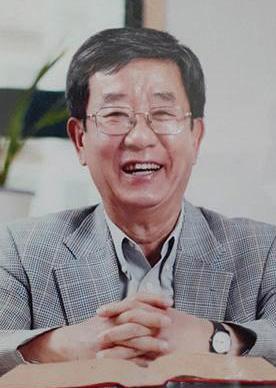
Park Nahm-Sheik is a native of Gwangju. After graduating from Chonnam National University, he went on to receive a master’s degree at the University of Hawaii and a PhD (applied linguistics) at Georgetown University, both in the U.S. Upon completing an illustrious career at Seoul National University, Prof. Park served as president of the International Graduate School of English.
The wall of former patients. (Melline Galani)
Area Sports Round-Up
A monthly overview of local sports, featuring area teams and brought to you…
By Zhang Jiuzhou (Julius)
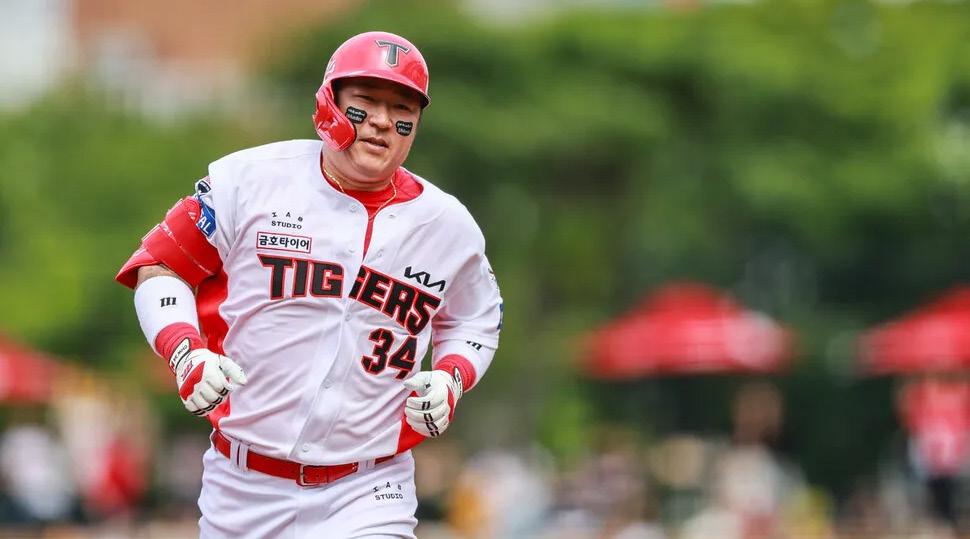
Kia Tigers: Holding the Line Amid Injury Chaos
Since the start of the 2025 KBO season, the Kia Tigers have been hit hard by a cascade of injuries to key players. Star infielder Kim Doyeong missed a month after suffering a hamstring injury in the season opener, only to injure the opposite leg upon returning. Team captain Na Sung-bum is out with a right calf strain and not expected back until July. Several other core players are also sidelined indefinitely due to muscle strains and leg issues.
As a result, the Tigers have been forced to shuffle players between the first and second teams, fielding makeshift lineups on a nightly basis. Remarkably, many starting lineups consist of
players whose combined annual salaries match that of Kim Do-yeong’s alone, yet they’ve managed to keep the team competitive – an achievement drawing both surprise and admiration.
Veteran slugger Choi Hyoung-woo, now in his 40s, is defying age and expectations. In May, he posted a league-best .407 batting average, a .721 slugging percentage, and a .505 onbase percentage, leading the KBO in all three categories. His 1.226 OPS (on-base plus slugging) made him the oldest player in league history to win an MVP of the Month award.
Emerging as an unlikely hero, Oh Seon-woo, 29, has seized his long-overdue opportunity after years of limited chances. Batting .316 with 3 home runs and 13 RBIs in 30 games, he’s also made
Veteran Choi Hyoung-woo in action. (Kia Tigers)
SPORTS
crucial defensive contributions in the outfield and at first base, stepping up in the absence of injured starters.
On the mound, foreign pitchers Adam Oller and James Naile have provided much-needed stability. Their consistent performances have blurred the line between ace and backup, forming one of the strongest foreign duos in Kia Tiger history.
Last year, the Tigers were widely regarded as the league’s most potent batting team. Their offense was so deep and talented that hitters often resolved tough situations with little strategic intervention. But this season, the injury-depleted lineup has faltered. The team’s scoring struggles have affected not only win–loss records but also player morale.
With over half the season remaining, Head Coach Lee Bum-ho faces the toughest test of his managerial tenure. Whether he can guide the Tigers through this injury crisis and restore their competitive edge remains a pressing question –and a matter of pride for the Gwangju faithful.

Gwangju FC snatched a 1–0 away victory over Pohang Steelers. (K League)
Gwangju FC: From Fairytale to Fiasco
Just two years ago, Gwangju FC was riding high. The 2023 season saw the club shatter records, defeat K League powerhouses, and finish third in the league, earning its first-ever berth in the
AFC Champions League Elite Playoff. Head Coach Lee Jung-hyo was hailed as a rising star in Korean football management. But in 2025, the club finds itself at the center of multiple scandals that threaten its credibility and future.
At the heart of the storm is an administrative oversight regarding Asani’s 2023 transfer, which triggered a FIFA-imposed ban on player registration due to the club’s failure to pay a $3,000 solidarity contribution. This fee, designed to reward youth clubs involved in a player’s development, was never processed – initially due to overseas remittance issues, and later due to staff absence. The employee responsible was on parental leave and missed FIFA’s official notification, which was sent via the KFA and AFC.
Unaware of the ban, Gwangju FC continued to sign and field new players during the off-season, raising concerns that they had used ineligible players in K League and ACLE matches. Several K League clubs have filed formal complaints, and some have even called for forfeitures. The KFA, in turn, admitted it had not verified the content of FIFA’s letter before forwarding it and acknowledged systemic failures in communication and oversight.
While Gwangju eventually paid the $3,000 and had the ban lifted, the damage was done. The KFA called the incident an “unintentional administrative mistake” and maintained that the players used were not “illegitimate” given the circumstances. Still, FIFA’s official position is pending, and the affair has shaken trust in both the club and the league’s governance.
Compounding the problem is Gwangju FC’s worsening financial condition. Despite receiving 10 billion won annually from the Gwangju city government, the club is now 5.8 billion won in debt – the worst financial standing in the K League. Violations of league financial health regulations could lead to unprecedented disciplinary action, including potential relegation to the second division (K League 2).
Fan anger has boiled over. On May 25, banners reading “Even management is on mental leave,” and “Mistakes spread like wildfire,” hung over Gwangju World Cup Stadium. Social media was flooded with criticism and sarcasm, questioning why supporters must bear the shame of repeated blunders.
Though the club has issued three public apologies via social media, including pledges to improve transparency and restructure internal controls, fans are demanding more than words. The sense of betrayal cuts deep. For a team that once symbolized the fresh air of Korean football, a true reckoning now looms.
AI Peppers: Veterans Return to Rekindle a Rebuild
TheAI Peppers is quietly rebuilding, with optimism slowly returning to the court. In the 2025 KOVO Asian quota draft, the Peppers selected Australian player Stephanie Weiler, only to learn she would be unavailable due to complications from a previous Achilles injury. In her place, the team signed Shimamura Haruyo, a 182-cm veteran middle blocker from Japan.
Shimamura brings a wealth of international experience, having represented Japan at the 2016 Rio Olympics and the 2020 Tokyo Olympics, and winning silver at the 2022 Asian Games. She spent over a decade with Japan’s NEC Red Rockets and now joins a club that, she says, feels like “a natural fit.” “I’m truly honored to join the AI Peppers,” Shimamura said through the club. “There’s a connection between NEC and this team, and I’m committed to helping us win.”
Head coach Chang So-yun, who played alongside Shimamura in her career, praised the signing: “She brings not only blocking and attacking skills but also the detail and discipline that come from years on the international stage.”
Adding further depth, the Peppers signed veteran outside hitter Ko Ye-rim, who rejoins Chang after previously playing under her at Korea

Expressway Corporation. Now fully recovered from double knee surgery, Ko expressed renewed motivation and praised the team’s young talent. “Even though the Peppers finished last season at the bottom, their potential is clear,” she said. “I want to contribute as a two-way player – on both offense and defense.”
Ko has quickly settled in, thanks to long-standing relationships with current teammates like Park Jeong-ah, Lee Han-bi, and Han Da-hye. Her goal is simple: to win. “This isn’t about age or fame – it’s about performance,” Ko said. “I joined a team that needs me. With everyone’s support, I’m ready to fight for the championship.”
Her return – and the team’s focus on blending youth with veteran leadership – may mark a turning point for a club long stuck in transition.

The Author

Zhang Jiuzhou (Julius) is from Harbin, China. He began writing in 2022 and has contributed to the Chinese media in Gwangju. He concurrently serves at a sports data company. He is pursuing a master’s degree in media and communications and is responsible for the Chinese Students Association at Chonnam National University.
AI Peppers sign veteran Ko Ye-rim. (Peppers Savings Bank)
From Kawasaki to Gwangju Shimamura
Haruyo’s Next Big Move
By Zhang Jiuzhou (Julius)
Originally looking to strengthen their attack and height at the net following the departure of Chinese star Zhang Yu, the AI Peppers used their No. 1 Asian draft pick to select Australian outside hitter Stefanie Weiler. However, hopes were dashed when Weiler recently suffered a torn Achilles tendon, ruling her out for the upcoming season. In response, Head Coach Chang So-yun moved swiftly to bring in Shimamura Haruyo, whose experience and consistency are expected to stabilize the Peppers’ most vulnerable position: middle blocker.
Born in Kanagawa, Japan, on March 4, 1992, Shimamura graduated from high school in 2010 and immediately joined NEC Red Rockets Kawasaki, where she had remained a core player. She made her debut for the Japanese national team in 2013, appearing at that year’s Montreux Volley Masters and earning a bronze medal at the inaugural U23 World Championship. Since then, she has competed in the 2015 World Cup, the 2016 Rio Olympics, the 2021 Tokyo Olympics, and the 2022 Asian Games in Hangzhou, where she won a silver medal.
In the 2024–25 SV.League season, Shimamura remained a pivotal force for the Red Rockets, ranking third in the league in attack efficiency. Her standout campaign earned her Best Middle Blocker and Fair Play Award honors, as well as a place on the 2025 Japan national team for the upcoming Volleyball Nations League.
Shimamura had previously expressed interest in playing in Korea, having scrimmaged against the AI Peppers in a preseason match last year. At that time, she praised the club’s preparation and team

celebrates
spirit. Despite being over 30, an age at which physical decline is often discussed in elite sports, Shimamura is expected to maintain her form due to her continued presence on the national team and her sharp game-reading skills.
While she stands at 182 cm – relatively short by modern middle blocker standards – Shimamura’s success has come from her precise timing, quick footwork, and strong coordination with setters.
With Shimamura stepping in, the Peppers are hopeful of finding greater balance in attack and defense. GS Caltex Assistant Coach Abo Kiyoshi, who previously selected Shimamura for the Japanese national team, expressed confidence in her upcoming KOVO debut: “I believe Shimamura will excel in the Korean league. Her leadership, skill, and experience will bring great value to the AI Peppers.”
As the team looks to climb from the bottom of the standings, the addition of Shimamura may provide the stability and veteran presence needed to help the youthful Peppers roster take the next step.

The Author

Zhang Jiuzhou (Julius) is from Harbin, China. He began writing in 2022 and has contributed to the Chinese media in Gwangju. He concurrently serves at a sports data company. He is pursuing a master’s degree in media and communications and is responsible for the Chinese Students Association at Chonnam National University.
Shimamura
after scoring during a match with the NEC Red Rockets. (AI Peppers)
July Upcoming Events
MUSICAL
Dr. Jekyll and Mr. Hyde – 20th
Anniversary

Dates: July 18–20 (Fri.–Sun.)
Times: 18 (Fri.) 7:30 p.m.; 19 (Sat.) 2:00 & 7:00 p.m.; 20 (Sun.) 2:00 & 7:00 p.m.
Venue: Gwangju Culture and Arts Center, Grand Theater
Reservations: NOL Interpark (Interpark ticket) (1544-1555)
Admission: VIP seats 170,000 won, R seats 140,000 won, S seats 110,000 won, A seats 80,000 won
EXHIBITIONS
New York Masters: Friends of Jackson Pollock and Mark Rothko

Dates: July 18 – October 9
Venue: ACC Cultural
Creation Center Complex, Exhibition Hall 6
Reservations: Naver, KakaoTalk, Ticketlink, Interpark
Admission: Adults 13,000 won, Youth and Children 10,000 won, Under 48 months – free
Age Restriction: All ages
Forum DiSeño: Gwangju and Modern Spirit

Dates: June 11 – August 17
Venue: Gwangju Museum of Art, Ha Jeong-woong Museum of Art
Reservations: Gwangju Museum of Art website
Admission: Free Inquiries: 010-6672-0639

Fluid Communication

CONCERTS
Dates: May 10, 2025 –January 15, 2026
Hours: 10:00 a.m. – 5:00 p.m. (Closed every Monday)
Venue: Grass and Straw Craft Museum, Planning Exhibition Hall
Exhibition Items: 135
Admission: Free Inquiries: 031-717-4538
Gwangju Symphony Orchestra Chamber Series IV: Identity

Time: July 3 (Thu.) 7:30 p.m.
Venue: Gwangju Culture and Arts Center, Small Theater
Reservations: Gwangju Culture and Arts Center website, Ticketlink
Admission: All seats 10,000 won
Age Restriction: Elementary school students and above
Inquiries: 062-613-8241

Permission Concert: Vocal War Season 2 – The War of Vocalists II CONCERTS
Planned Performance 11:00 Music Walk Masterpiece Series IV: The Old Man and the Sea

Time: July 29 (Tue.)
11:00 a.m.
Venue: Gwangju Culture and Arts Center, Small Theater
Reservations: Gwangju Culture and Arts Center website, Ticketlink
Admission: R seats 20,000 won, S seats 10,000 won
Age Restriction: Elementary school students and above
Inquiries: 062-613-8241
GAC Concert, Four Seasons, “Choi Song Ha & Kim Do Hyun Duo Recital”

Time: July 29 (Tue.) 11:00 a.m.
Venue: Gwangju Culture and Arts Center, Small Theater
Reservations: Gwangju Culture and Arts Center website, Ticketlink
Admission: R seats 20,000 won, S seats 10,000 won
Age Restriction: Elementary school students and above
Inquiries: 062-613-8241
2025 Peppertones Club Tour

Time: July 20 (Sun.) 5:00 p.m.
Venue: Cultural Space Bohemian
Reservations: NOL ticket
Admisson: All seats 66,000 won
Age Restriction: 8 years of age or older
Inquiries: 1544-1555

Date: July 12 (Sat.)
Times: 2:00 & 6:00 p.m.
Venue: Gwangju Culture and Arts Center, Grand Theater
Reservations: Gwangju Culture and Arts Center website, Ticketlink, Interpark ticket, NOL ticket
Admission: VIP seats 143,000 won, R seats
121,000 won, S seats 110,000 won
Age Restriction: 8 years of age or older
Inquiries: 1544-1555
Gwangju Philharmonic Orchestra: Brilliant Colors

Time: July 25 (Fri.) 7:30 p.m.
Venue: Gwangju Culture and Arts Center, Grand Theater
Reservations: Gwangju Culture and Arts Center website, Ticketlink
Admission: R seats 30,000 won, S seats 20,000 won, A seats 10,000 won
Age Restriction: Elementary school students and above
Inquiries: 062-613-8241
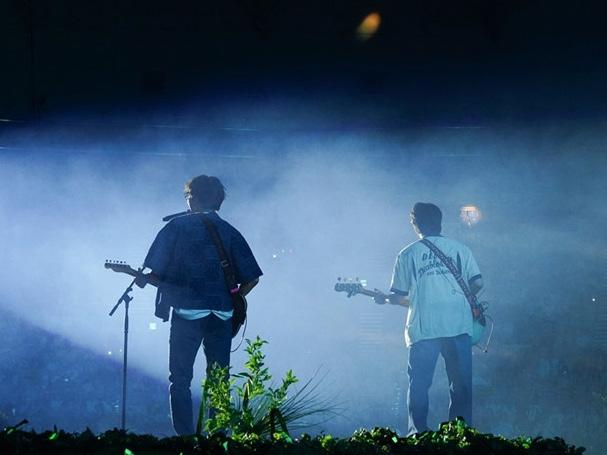
Peppertones. (Antenna)
CONCERTS
“Jazz and the City of Desire, New York” by Art Columnist Jeon Won-kyung

Date: July 30 (Wed.)
Time: 11:00 a.m.- 12:10 p.m.
Venue: ACC Art Theater, Theater 2
Reservations: Asian Cultural Center website, Call center. Onsite purchase
Admisson: R seats 30,000 won, S seats 20,000 won
Age Restriction: 7 years of age or older Inquiries: 1899-5566
2025 Melomance National Tour Concert: Romance Station

Dates: July 26–27 (Sat.–Sun.)
Times: 26 (Sat.) 5:00 p.m., 27 (Sun.) 4:00 p.m.
Venue: Kim Daejung Convention Center, Multipurpose Hall
Reservations: Yes24
Admission: VIP seats
143,000 won, R seats, 132,000 won, S seats 110,000 won
Age Restriction: No preschoolers or younger Inquiries: 1544-6399
PERFORMANCES
Mondrian: The Line of Obsession

Dates: July 18–19 (Fri.–Sat.)
Times: 18 (Fri.) 7:30 p.m., 19 (Sat.) 3:00 p.m.
Venue: ACC Art Theater, Theater 1
Reservations: Asian Cultural Center website, Call center. Onsite purchase
Admisson: R seats 50,000 won, S seats 30,000 won
Age Restriction: 7 years of age or older Inquiries: 1899-5566
Gwangju City Ballet’s Visiting Cultural Performance

Time: July 4 (Fri.) 7:00 p.m.
Venue: Transportation Culture Training Center
Reservations: None required
Admisson: Free
Age Restriction: None Inquiries: 062-522-8716

Compiled by Jung Yeonseo.

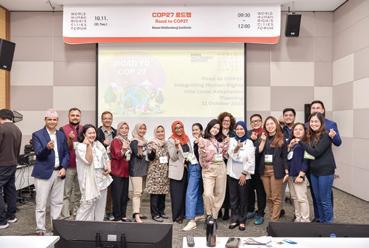

GWANGJU INTERNATIONAL CENTER




For only 50,000 won/year, you help the GIC provide a space for exchanges for the local and international communities to learn and experience various cultures from around the world and to promote respect for diversity and inclusivity.
Bene�its as a GIC member:
Receive the Gwangju News every month by email.
Priority for participation in programs.
Get discounts on paid programs and space rentals.
Borrow books and materials from the GIC Library. Get receipts for contributions provided for year-end tax settlement.
(61475) 5 Jungang-ro 196-beon-gil (Geumnam-ro 3-ga), Dong-gu, Gwangju, Korea Tel. 062-226-2732 Email. gic@gic.or.kr Web. www.gic.or.kr
GIC

